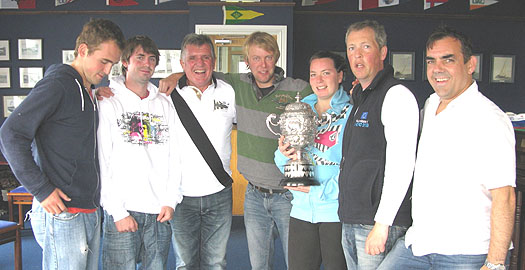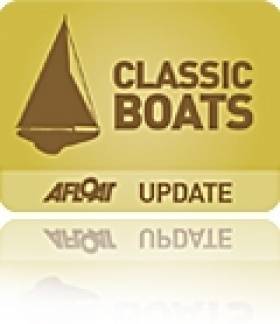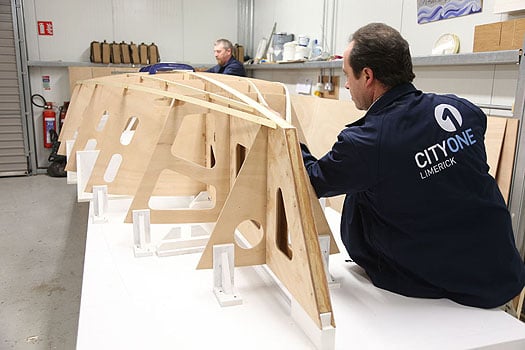Displaying items by tag: W M Nixon
#oldestyachtclubintheworld – Following WM Nixon's latest blog on Afloat.ie where he gives an account of early Irish yachts and yachting, leading yachting historian Hal Sisk has added to the story of how the sport was formed with claims the amateur sport of sailing became established in the 1850s on Dublin Bay.
Sisk also reveals that contrary to the conventional foundation myth for yachting, the English did not introduce yacht racing in the 1660s. Instead, a once off race is recorded on Dublin Bay where Sir William Petty wrote that he had successfully matched his experimental 30–ft catamaran on several occasions in the winter of in the winter of 1662/3.
In a written comment at the end of Nixon's Saturday blog: Sailing Artefacts Prove Irish Yacht Clubs Are The Oldest In The World, Sisk also asks how significant were the early yacht clubs and were the early yachts truly leisure craft?
He gives as an example, the Stuart royal yachts that were mini warships, built from funds voted for the Navy and in battle with the Dutch in 1673.
Finally, Sisk says the worldwide sport we know today owes more to the pioneering amateurs of Dublin Bay than to the wealthy yacht owners of the 18th and early 19th century. Thus as well as several spectacular silver trophies, the key figures of the Dublin's Royal Alfred YC gave us in the 1850s to 1870s the following yachting firsts:
--World's First National Yacht Racing Rules and Regulations (published by the RAYC in 1872, adopted by the Yacht Racing Association)
--World's First Offshore Racing Club (1868 to 1922)
--World's First Single and Double handed races (1872)
--World's Premier Amateur Sailing Club (1857--)
Add to that the Water Wags of Dublin giving the world the One Design concept in 1887, and we may well ask who made the greater contribution to our sport and who left the greater lasting influence?
Hal Sisk's full comments can be read a the end of the WMN Nixon's blog here.
#yachtclubs – The antiquity of Irish recreational sailing is beyond dispute, even if arguments arise as to when it started, and whether or not the Royal Cork YC really is the world's oldest club in its descent from the Water Club of the Harbour of Cork from 1720. But all this seems academic when compared with the impression made by relics of Ireland's ancient sailing traditions.
In just six short years, the Royal Cork Yacht Club will be celebrating its Tercentenary. In Ireland, we could use a lot of worthwhile anniversaries these days, and this 300th has to be one of the best. The club is so firmly and happily embedded in its community, its area, its harbour, in Munster, in Ireland and in the world beyond, that it is simply impossible to imagine sailing life without it.
While the Royal Cork is the oldest, it's quite possible it wasn't the first. That was probably something as prosaic as a sort of berth holder's association among the owners of the ornamental pleasure yachts which flourished during the great days of the Dutch civilisation in the 16th and 17th Centuries. They were based in their own purpose-built little harbours along the myriad waterways in or near the flourishing cities of The Netherlands. Any civilisation which could generate delightful bourgeois vanities like Rembrandt's Night Watch, or extravagant lunacies such as the tulip mania, would have had naval-inspired organised sailing for pleasure and simple showing-off as central elements of its waterborne life.
Just sailing for pleasure and relaxation, rather than going unwillingly and arduously afloat in your line of work, seems to have been enough for most. Thus racing – which is the surest way to get some sort of record kept of pioneering activities – was slow to develop, even if inter-yacht matches were held, particularly once the sport had spread to England with the restoration of Charles II in 1660.
Ireland had not the wealth and style of either Holland or England, but it had lots of water, and it was in the very watery Fermanagh region that our first hints of leisure sailing appeared. It's said of Fermanagh that for six months of the year, the lakes are in Fermanagh, and for the other six, Fermanagh is in the lakes. Whatever, the best way to get around the Erne's complex waterways system, which dominates Fermanagh and neighbouring counties, was by boat. By the 16th Century Hugh Maguire, the chief of the Maguires, aka The Maguire, had a Lough Erne-based fleet, some boats of which were definitely for ceremonial and recreational use.
Sport plays such a central - indeed total - role in Irish life that it's highly likely these pleasure sailing boats were sometimes used for racing. However, the first recorded race anywhere in Ireland took place in Dublin Bay in 1663 when the polymath Sir William Petty, having built his pioneering catamaran Simon & Jude, then organised a race with a Dutch sailing vessel and a local "pleasure boatte" of noted high performance. This event, re-sailed in 1981 when the indefatigable Hal Sisk organised the building of a re-creation of the Simon & Jude, resulted both times in victory for the new catamaran. But because a larger sea-going version of the Simon & Jude, called The Experiment at the suggestion of Charles II himself, was later to founder with all hands while on a testing voyage in the Bay of Biscay, the multi-hull notion was abandoned in Europe for at least another two centuries.
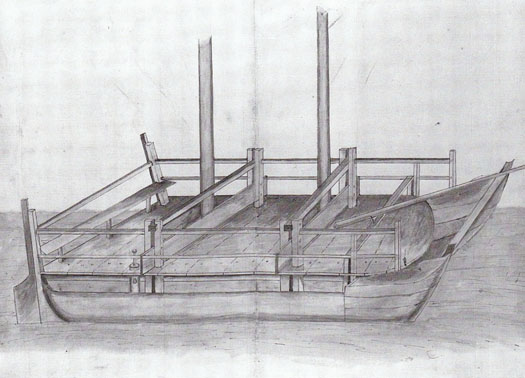
Contemporary drawing of the 17th Century catamaran Simon & Jude, which was built in Dublin and tested in the bay in an early "yacht race" in 1663.
We meanwhile are left wondering just what was this "pleasure boatte" was, and who owned and sailed it. Its existence and good sailing performance seems to have been accepted as unremarkable in Dublin Bay, yet no other record or mention of it has survived.
It was the turbulent life of Munster in the 17th Century which eventually created the conditions in which the first yacht club was finally formed. As the English Civil War spread to Ireland at mid-Century with a mixture of internecine struggle and conquest, the Irish campaigner Murrough O'Brien, the Sixth Baron Inchiquin, changed sides more than once, but made life disagreeable and dangerous for his opponents whatever happened to be the O'Brien side for the day.
Yet when the forces supporting Charles II got back on top in 1660 after the death of Cromwell in 1658, O'Brien was on the winning side. As the dust settled and the blood was washed away, he emerged as the newly-elevated Earl of Inchiquin, his seat at Rostellan Castle on the eastern end of Cork's magnificent natural harbour, and his interests including a taste for yachting acquired with his new VBF Charles II.
But there was much turmoil yet to come with the Williamite wars in Ireland at the end of the 17th Century. Yet somehow as the tide of conflict receded, there seemed to be more pleasure boats about Cork Harbour than anywhere else, and gradually their activities acquired a level of co-ordination. The first Earl of Inchiquin had understandably kept a fairly low profile once he got himself installed in his castle, but his descendants started getting out a bit and savouring the sea. So when the Water Club came into being in 1720, the fourth Earl of Inchiquin was the first Admiral.
In the spirit of the times, having an aristocrat as top man was sound thinking, but this was truly a club with most members described as "commoners", even if there was nothing common about their exceptional wealth and their vast land-holdings in the Cork Harbour area. Much of it was still most easily reached by boat, thus sailing passenger vessels and the new fancy yachts interacted dynamically to improve the performance of both.
Yet there was no racing. Rather, there was highly-organised Admiral Sailing in formation, something which required an advanced level of skill. However, many of the famous club rules still have a resonance today which gives the Water Club a sort of timeless modernity, and bears out the assertion by some historians that, as it all sprang to life so fully formed, the formation date of 1720 must be notional, as all the signs are that there had been a club of some sort for years beforehand.
But either way, it makes no difference to the validity or otherwise of the rival claim, that the Squadron of the Neva at St Petersburg in Russia, instituted by the Czar Peter the Great in 1718 to inculcate an enthusiasm for recreational sailing among Imperial Russia's young aristocrats, was the world's first yacht club. It was no such thing. It was in reality a unit of the Russian navy, and imposed by diktat from the all-powerful ruler. As such, it was entirely lacking the basic elements of a true club, which is a mutual organisation formed by and among equals.
Yet as the Water Club of the Harbour of Cork had no racing with results published in what then passed for the national media, we are reliant on the few existing club records and some travel writing from the time for much of our knowledge of the early days of the Water Club. That, and the Peter Monamy paintings of the Water Club fleet at sea in 1738.
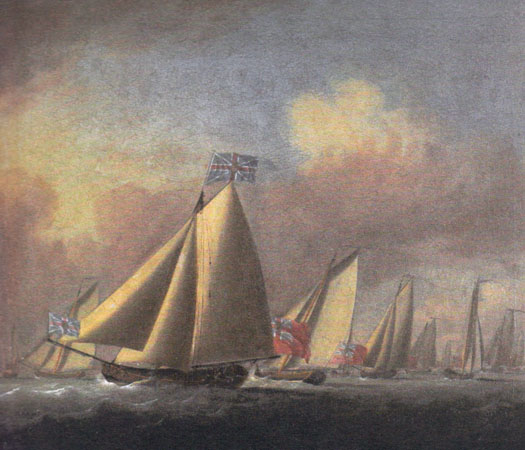
A remarkably well-disciplined fleet. Peter Monamy's 1738 painting of the yachts of the Water Club at sea off Cork Harbour. They weren't racing, but were keeping station in carefully-controlled "Admiral Sailing". Courtesy RCYC
Fortunate indeed are the sailors of Cork, that their predecessors' activities should have been so superbly recorded in these masterpieces of maritime art. The boats may look old-fashioned to a casual observer, yet there's something modern or perhaps timeless in this depiction of the fleet sailing in skilled close formation, and pointing remarkably high for gaff rigged boats as they turn to windward. Only a genuine shared enthusiasm for sailing could have resulted in such fleet precision, and in its turn in a memorable work of art. It is so much part of Irish sailing heritage that we might take it for granted, but it merits detailed study and admiration no matter how many times you've seen it already.
Shortly after Monamy's two paintings were completed, Ireland entered a period of freakish weather between 1739 and 1741 when the sun never shone, yet it seldom if ever rained, and it was exceptionally cold both winter and summer. It is estimated that, proportionately speaking, more people died in this little known famine than in the Great Famine itself 104 years later. While the members of the Water Club would have been personally insulated from the worst of it, the economic recession which struck an intensely agricultural area like Cork affected all levels of society.
Thus the old Water Club saw a reduction in activity, but though it revived by the late 1740s, the sheer energy and personal commitment of its early days was difficult to recapture, and by the 1760s it was becoming a shadow of its former self. Nevertheless there was a revival in 1765 and another artist, Nathanael Grogan, produced a noted painting of Tivoli across from Blackrock in the upper harbour, with a yacht of the Water Club getting under way for a day's recreation afloat, the imminent departure being signalled by the firing of a gun.
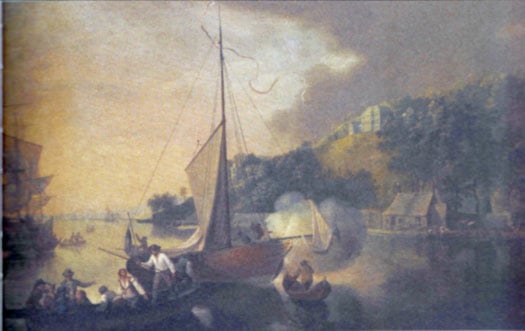
The best way to get the crew on board....on upper Cork Harbour at Tivoli in 1765, a yacht of the reviving Water Club fires a gun to signal imminent departure.
However, it was on Ireland's inland waterways that the next club appeared – Lough Ree Yacht Club came into being in 1770, and is still going strong. That same year, one of the earliest yacht clubs in England appeared at Starcross in Devon, but it was in London that the development pace was being most actively set with racing in the Thames for the Cumberland Fleet. Some members of this group, after the usual arguments and splits which plague any innovative organisation, in due course re-formed themselves as the Royal Thames Yacht Club in the early 1800s. But the famous yet unattributed painting of the Cumberland Fleet racing on the Thames in 1782, while it is slightly reminiscent of Monamy's painting of the Water Club 44 years earlier, undoubtedly shows boats racing. And they'd rules too – note the port tack boat on the right of the picture bearing off to give way to the boat on starboard.
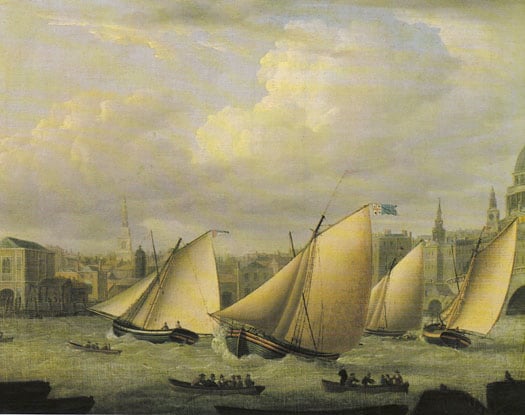
Definitely racing – the Cumberland Fleet, precursor of the Royal Thames Yacht Club, racing in the River Thames at Blackfriars in 1782.
The Thames was wider in those days, but even so they needed strict rules to make racing possible. Dublin Bay offered more immediate access to open water, and there were certainly sailing pleasure boats about. When the Viceroy officially opened the Grand Canal Dock on April 23rd 1796, it was reported that the Viceregal yacht Dorset was accompanied by a fleet of about twenty ceremonial barges and yachts. Tantalisingly, the official painting is almost entirely focused on the Dorset and her tender, while the craft in the background seem to be naval vessels or revenue cutters.
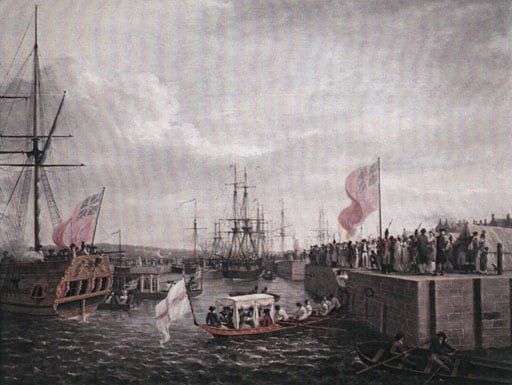
This painting of the opening of the Grand Canal Dock in 1796 tends to concentrate on the ceremonials around the Viceroy's yacht Dorset in the foreground, but fails to show clearly any of the several privately-owned yachts which were reportedly also present....
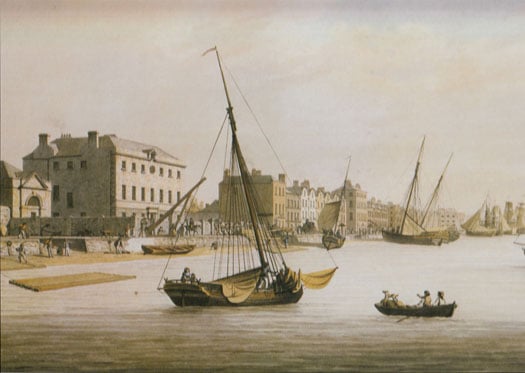
.......but this illustration of the old Marine School on the South Quays in Dublin in 1803 seems to have a yacht – complete with owner and his pet dog on the dinghy in the foreground – anchored at mid-river.
However, a Malton print of the Liffey in 1803 shows clearly what is surely a yacht, the light-hearted atmosphere of waterborne recreation being emphasised by the alert little terrier on the stern of the tender conveying its owner in the foreground Meanwhile in the north of Ireland there was plenty of sailing space in Belfast Lough, while Belfast was a centre of all sorts of innovation and advanced thinking. Henry Joy McCracken, executed for his role in the United Irishmen's rising in 1798, was a keen pioneer yachtsman. As things took a new turn of determined money-making in Belfast after the Act of Union of 1801, some of his former crewmates were among those who formed the Northern Yacht Club in 1824, though it later transferred its activities across the North Channel to the Firth of Clyde, and still exists as the Royal Northern & Clyde YC.
Meanwhile in 1806 the old Water Club of the Harbour of Cork had shown new signs of life, but one result of this was an eventual agreement among members - some of them very old indeed, some representing new blood - that the club would have to be re-structured and possibly even given a new name in order to reflect fresh developments in the sport of yachting. The changeover was a slow business, as it had to honour the club's history while giving the organisation contemporary relevance. Thus it was 1828 before the Royal Cork Yacht Club had emerged in this fully fledged new form, universally acknowledged as the continuation of the Water Club, and incorporating much of its style.
But it was across the north on Lough Erne in 1820 that the world's first yacht club specifically set up to organise racing was formed, and Lough Erne YC continues to prosper today, its alumnae since 1820 including early Olympic sailing medallists and other international champions.
There must have been something in the air in this northwest corner of Ireland in the 1820s, for in 1822 the men who sailed and raced boats on Lough Gill at Sligo had a pleasant surprise. Their womenfolk got together and raised a subscription for a handsome silver trophy to be known as the Ladies' Cup, to be raced for annually – and it still is.
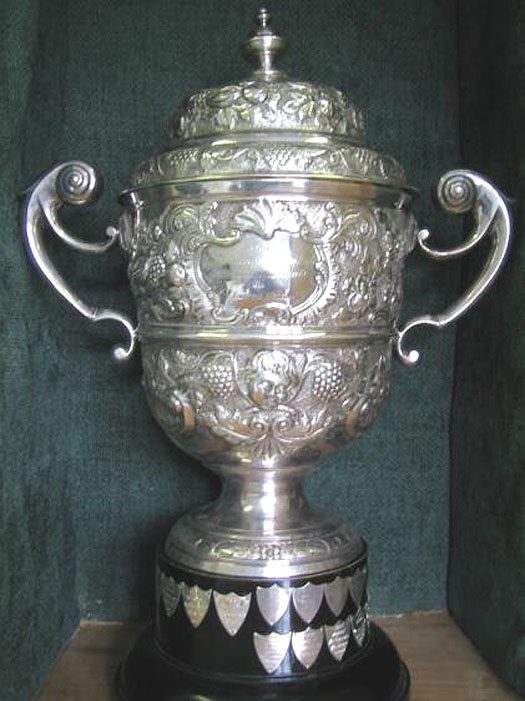
Instituted in 1822, the Ladies' Cup of Sligo YC is the world's oldest continually-contested annual sailing trophy.
Annual challenge cups now seem such a natural and central part of the sailing programme everywhere that it seems extraordinary that a group of enthusiastic wives, sisters, mothers and girlfriend in northwest Ireland were the first to think of it, yet such is the case. Or at least theirs is the one that has survived for 192 years, so its Bicentenary in 2022 is going to be something very special.
Those racing pioneers of the Cumberland Fleet had made do with new trophies freshly presented each year. And apparently the same was the case initially at Lough Erne. But not so very far down the road, at Sligo, somebody had this bright idea which today means that the museum in Sligo houses the world's oldest continually raced-for sailing trophy, and once a year it is taken down the road to the Sligo YC clubhouse at Rosses Point to be awarded to the latest winner – in 2013, it was the ever-enthusiastic Martin Reilly with his Half Tonner Harmony.
The Ladies Cup was won in 2013 by Martin Reilly's Half Tonner Harmony. Pictured with their extremely historic trophy are (left to right) Callum McLoughlin, Mark Armstrong, Martin Reilly, John Chambers, Elaine Farrell, Brian Raftery and Gilbert Henry
However, although the Ladies' Cup may have pioneered a worthwhile trend in yacht racing, it wasn't until 1831 that they thought of inscribing the name of the winner, and that honour goes to Owen Wynne of Hazelwood on the shores of Lough Gill. But by that time the notion of inscribing the winners was general for all trophies, and a noted piece of the collection in the Royal Cork is the Cork Harbour Regatta Cup 1829, and on it is inscribed the once-only winner, Caulfield Beamish's cutter Little Paddy.
The name of noted owner, skipper and amateur yacht designer Caulfield Beamish came up here some time back, when we were discussing how in 1831 he took a larger new yacht to his own design, the Paddy from Cork, to Belfast Lough where he won a stormy regatta. So you begin to understand the mysterious enthusiasm people have for sacred relics when you see this cup with its inscription, and realise that it's beyond all doubt that this now-forgotten yet brilliant pioneer of Cork Harbour sailing development personally held this piece of silverware.
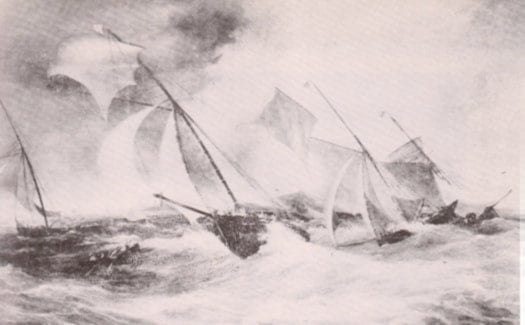
Caulfield Beamish's new cutter Paddy from Cork (which he designed himself) winning a stormy regatta in Belfast Lough in 1831
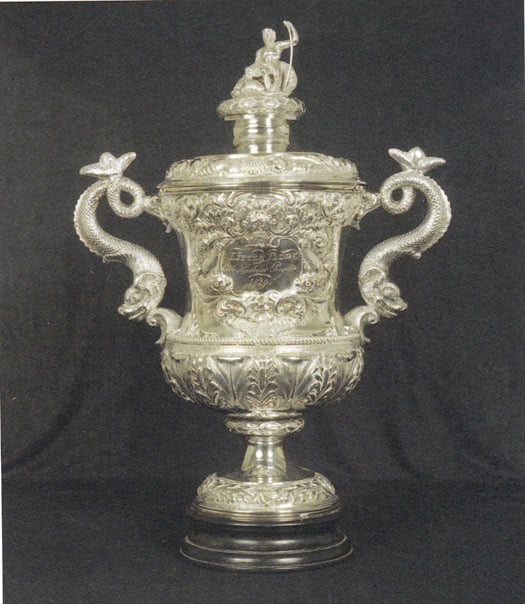
The Cork Harbour Regatta Cup of 1829.....Courtesy RCYC
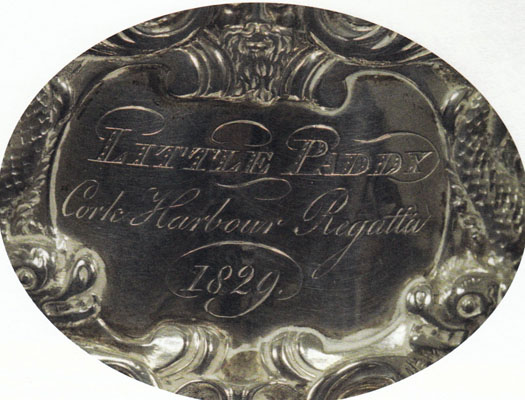
....and on it is inscribed the winner, Caulfield Beamish's earlier boat, Little Paddy, which he also designed himself. Courtesy RCYC
Another pioneer in yacht racing at the time was the Knight of Glin from the Shannon Estuary, who in 1834 was winning all about him with his cutter Rienvelle, his season's haul including a silver plate from a regatta in Galway Bay – it's now in Glin Castle – while he also seems to have relieved fellow Limerick owner William Piercy of £50 for a match race in Cork Harbour against the latter's cutter Paul Pry.
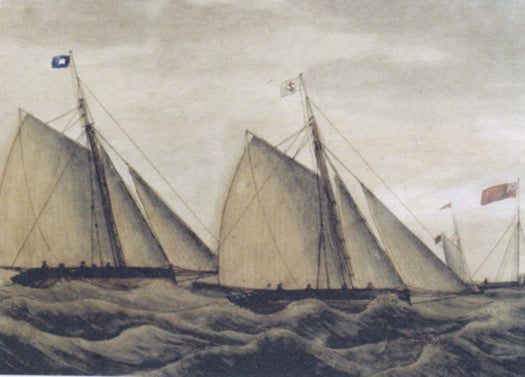
The lads from Limerick hit Cork. William Piercy's Paul Pry racing for a wager of £50 against the Knight of Glin's Rienvelle in Cork Harbour in 1834. When Paul Pry won Cork Harbour Regatta a few weeks later, the band on the Cobh waterfront played Garryowen. Courtesy RCYC
But of all the fabulous trophies in the Royal Cork collection, the one which surely engenders the most affection is the Kinsale Kettle. It goes back "only" to 1859, when it was originally the trophy put up for Kinsale Harbour Regatta. But this extraordinarily ornate piece of silverware was not only the trophy for an annual race, it was also the record of each race, as it's inscribed with brief accounts of the outcomes of those distant contests.
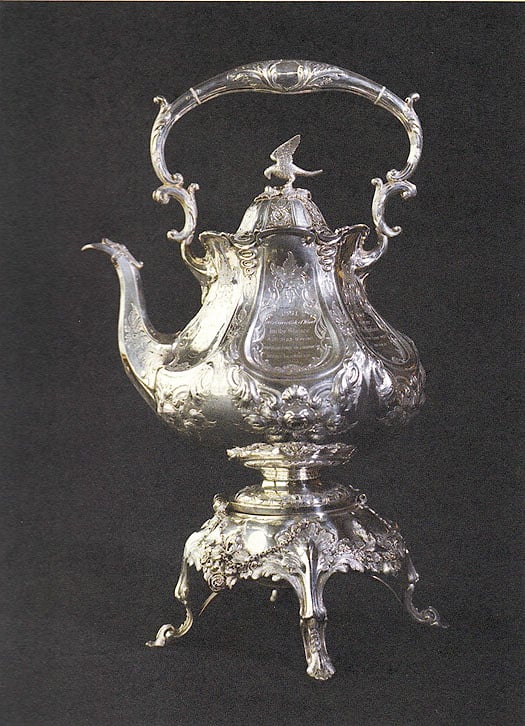
An extraordinary piece of Victorian silverware. The "Kinsale Kettle" from 1859 is now the Royal Cork YC's premier trophy.
Today, it continues to thrive as the Royal Cork Cup, the premier award for Cork Week. The most recent winner in 2012 was Piet Vroon with his superb and always enthusiastic Tonnere de Breskens. The fact that this splendid ambassador for Dutch sailing should be playing such a central role in current events afloat here in Ireland brings the story of our sport's artworks and historical artefacts to a very satisfactory and complete circle.
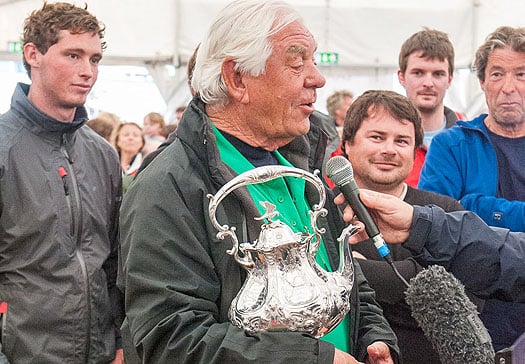
More tea, skipper? The current holder of the Kinsale Kettle, aka the Royal Cork Cup, is Piet Vroon of Tonnere de Breskens. Photo: Bob Bateman
Irish Sailors Show the Way for Chill–Out Sailing
#chillout – As the sailing community ponders the global fall-off in casual sailing numbers, leading sailor Ken Read reckons that one of the reasons is because our sport is getting too serious. He says it's time for most sailors to take a chill-pill. W M Nixon muses on how this suggestion is reflected in Ireland.
Ken Read, former Volvo World Race skipper of notable success, and holder of heaven only knows how many major championships and sailing records, is these days the President of North Sails. A nice little earner, you might say. Let's hope so. But there's much more to it than that.
Being President of North is top of the tops. Time was when the head honcho at Hood Sails, particularly when it was Ted Hood himself, was the special one, filling a unique and highly visible position in the big picture. And other leading global sailmaking brands have also been on this pinnacle from time to time. But these days, Ken Read is the man. He holds the key point in the middle of the triangle formed by the marine industry on one side, the local, national and international sailing organisations on the other, and the sailors themselves on the third. By the nature of their trade and the way it operates, sailmakers are connected every which way, and the world's top sailmaker speaks for all.
So when the President of North Sails advocates a change of sailing attitude at a recent convention of J Boat dealers in America, the sailing world is well advised to take notice. It may be that he said things that many of us have been saying in a different form for many years. But the fact that it was said by the President of North Sails, and said in a concise and forceful yet good-humoured way, uniting many strands of thinking, was something which gave it an impact which no other leading commentator could achieve.
But then Ken Read has always been unique, ever since he was clearly having the time of his life as he rose to international prominence through the ranks of the J/24 Class. He seems to have an enviable gift of knowing how to party when it's right, and how to sail intensely well when the situation demands it. He inspires a very special loyalty among crews, and an admiration and affection among people generally when the big sailing events come to town.
Galway's Volvo Race stopovers provided the classic case in point. Long before selfies became all the rage, just about every club sailor who was next or near Galway docks came proudly home with a photo of themselves and their mates with Kenny Read. As for the great man himself, as the fleet raced away down past the Cliffs of Moher at breakneck speed, he still found time to post a message saying how much he'd enjoyed his time in Galway, sending out a cheery stream of consciousness about this great harbour town with a pub on every corner, and everybody in those pubs wants to buy you a beer, and the greatest golf links he'd ever played down at Doonbeg, so what's not to like?
But just in case anyone was in any doubt about how he'd fully immersed himself in the Galway and Irish thing, as the fleet had headed out through the Galway lock, here was the man himself in a Paddy hat you'd need a licence for. We gave you a glimpse of it at the top this morning, but the full impact needs a bit of space, so here it is again in untrimmed glory. It's something to be savoured, though I doubt you'll find it displayed on the walls of the North Sails boardroom.
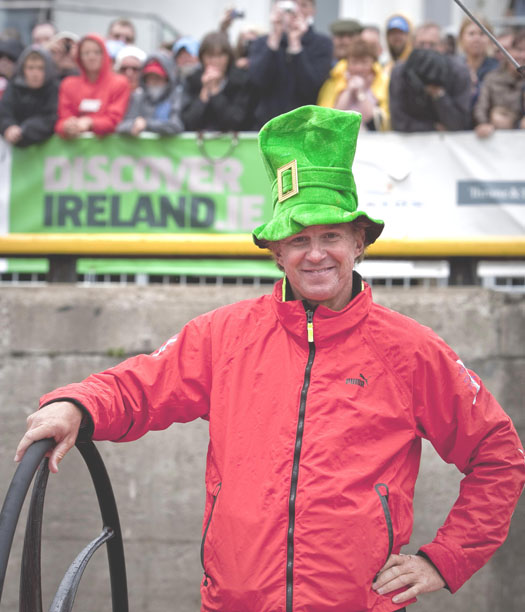
The Full Monty. Only a man very comfortable with himself would set out to go to sea in the most public way possible, and attired like this. Photo: David Branigan
Ken Read got his main point made immediately at the J Boat gathering. He wants recreational racing to take a chill pill. He argues that the message is simple: the harder we play, and the more we invest in our recreation, the fewer people will want to take part in the game.
You'd guess the key phrase is "recreational racing". In other words, he's talking of what you and I do in club racing, at local, regional and class championships, and in offshore races on the nearest bit of open water.
Obviously we're not talking Olympic aspirations, or indeed sailing towards one of the 143 world titles which sailing offers to dedicated participants. But if we did want a scapegoat for people being turned off sailing, I'd be minded to blame the dominance of the Olympics in the public's thinking about minority sports.
The Olympic circus is the sow that eats others' farrow. It takes up little specialist sports, and then forces them into unnatural shapes in order to attract their brief moment of global Olympic attention. And once it has them hooked, it dictates the amount of media interest they have to continue to generate in order to stay in the Olympic lineup. To do this, they contort themselves and their events even further in every unnatural way possible in order to get what is, ultimately, no more than the most ephemeral passing interest, and that from people whose attention really isn't worth the effort in the first place.
Sailing is essentially about participation, it's not naturally spectator friendly. The only truly absorbing way to watch a yacht race is by taking part in it, and enjoyable yacht races can take many forms. But as the Olympic juggernaut gathered speed and power during the past eighty and more years, the Olympic "ideal" of the purest possible yacht racing, with windward starts all staged from committee boats as clear as possible from the influence of the land on the breeze, and preferably in a tide-free zone, became the dominant theme. Even the most homely club sailing programmes found themselves being forced by fashion into the strait jacket of aping the sacred "Olympic course", and raced by one designs too.
But in his presentation to the J Boat men, Ken Read has blown it all out of the water. The Must Read list is:
- Rally and pursuit races are fun, and gaining in popularity.
- Get rid of the AP flag; people want to sail, not float around waiting for perfect conditions.
- Stop worrying that the starting line is off by 5 degrees; start the race
- Get rid of uncomfortable gut hiking off the lower lifelines
- All spinnakers should be coloured; no more white!
- Start some races downwind
- More variety of courses; not only W-L
- Increased use of reaching legs, particularly with boats that can plane
- Involve youngsters more in big boat sailing; not all want to do dinghies.
- More public access to the water, then sailing would become even more important
- Pros should be helping the amateurs by being available at regattas to give help and guidance.
It's a wish list which carries a couple of real stings in the tail. Making recreational waters more publicly accessible immediately suggests that you'll need public employees and regulators to run such access amenities, not only in supervising the launchings and retrievings, but also in keeping the facilities in good order. With experience painfully teaching us that what's everybody's business is nobody's business, the increase of public access to an intensely personal vehicle sport like sailing is quite a challenge.
As for suggesting that the top pros should be available at regattas to help amateurs, that's a tricky one. With much of modern sailing already having a pro-am mix in many events, you can see that there'll be competition to get the attention of top pros, and money will talk. That said, every so often you hear of sailors of truly global stature such as Robert Scheidt of Brazil, whose presence at some ordinary event manages to enhance everyone's day afloat.
But as for Irish sailing learning from the Read programme, it's really more a case of learning anew. For instance, this business of getting all ages involved in big boat racing. Well, we featured it here a couple of weeks ago with our analysis of the success of Dublin Bay Sailing Club. Inevitably, some subsequent commentators complained that while Dublin Bay may provide dinghy racing at mid-week, Saturdays are dominated by keelboats and particularly cruisers. Instead of being an undesirable situation, this sounds rather like what Ken Read is advocating.
The fact is, cruisers are simply much less hassle to organise for weekend racing. They're afloat and ready to go, you can even use them as changing rooms, they don't need crash boats, and they can provide that easygoing sociable atmosphere which needn't involve a debilitating level of commitment. Yet it gets people out enjoying sailing - and they come back for more. Dinghies by contrast are a flighty bunch, and you've no sooner gone to all the trouble of setting up regular Saturday racing for them than you find they're on their trailers, haring down the motorway to some distant regional championship.
Read's opening suggestion about rally and pursuit races will ring a special bell for anyone whose formative sailing years were at Ballyholme Bay on Belfast Lough. Although BYC is now the north's leading performance and dinghy events club, its membership is eclectic and its fleet diverse, so for as long as anyone can remember, they concluded their traditional season with a pursuit race.
These days their season is virtually year-round, but the Menagerie Race, as it's sometimes known, is still sailed every September. It generates excitement at all levels. Beforehand, with handicaps being taken at the start, there's the fascination of the handicapper's calculations to allot starting times for each class and the many individual boats from small dinghies to large cruisers. Then on the day itself, the weather is of special interest as different conditions better suit different boats. And then the finish is one of high excitement, as the final leg is sailed across the bay towards the line close off the club, a time of drama as everyone from biggest to smallest closes in towards a finish which may be decided by inches – it has not been unknown for a couple of crewmembers to be straining on the stemhead as they hold the spinnaker pole out forward well beyond the pulpit to gain a couple of feet.
Unlike your usual handicap race where the result may have to wait for the finish of the last boat across, a pursuit race provides a finish which is instantly satisfying for the winner at least, and also for spectators of limited attention span, which is just about all of them these days.

Lufra in her youth, tearing along on the Clyde in the 1890s. Photo courtesy Iain McAllister
As anyone with experience of sailing at Ballyholme will know, the end-of-season Menagerie Race, as its quaint name suggests, goes back a long way. But it's usually better known as the Lufra Cup, and has been known as such since the mid-1940s, when it was presented for a race which was already a much-loved part of the programme.
So who or what was Lufra? In the 19th and early 20th Centuries, the romantic Scottish-flavoured novels of Sir Walter Scott were best sellers. As the new sport of yachting developed, on both sides of the North Channel the work of Scott provided a fertile source of interesting names for boats – an entire class, the 18ft Belfast Lough Waverleys established 1903, derived all their evocative names from his long sequence of Waverly novels.
Lufra was a dog, but a noble and swift one. He figured in Scott's poem The Lady of the Lake (1810), a title which was itself borrowed from the Arthurian legend, but equally has since been borrowed again to name more inland-cruising water-buses than is decent. Whatever, Scott's long narrative poem recounted the usual bloodthirsty Scottish melodrama, set this time in the Trossachs. But from a cast which was large if not quite in the thousands, the character who stays in the mind is "brave Lufra, the fleetest hound in the North".
You'd think a unique and swinging name like that – I've always heard it pronounced "loof-rah" – would be encouragement enough to build a boat, and one of gallant performance and character at that. But it wasn't until 1894 that the first boat we know of called Lufra appeared from the busy G L Watson design office. Built by P R MacLean of Rosneath for T K Laidlaw of Glasgow, Lufra came at an interesting time of design development. With the appearance of the spoon-bow with the successful 10-Rate Dora in 1891 (she also had a centreboard, but that's by the way), the Watson office had started moving away from the clipper or fiddle bow, and with the big boats Britannia and Valkyrie in 1893, they developed a new kind of keel, more definably an appendage to the hull, and with a more marked toe which greatly improved windward ability.

The timeless profile of Britannia in 1893. She still looked up-to-date at the end of her life in 1936, by which time her shape was also used for offshore racers and fast cruisers.
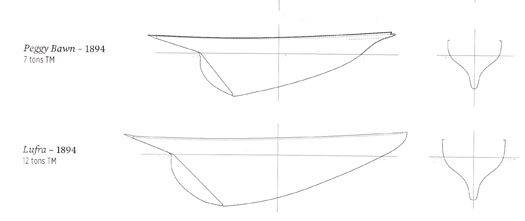
The profiles and hull sections of Peggy Bawn and Lufra. Though they were broadly similar below the waterline, the fact that Lufra had an above-water profile similar to Britannia made her seem much more modern
But most yachtsmen, particularly those with an interest in occasional cruising, are conservative types. So for several years the Watson team were still being commissioned to design new boats of an older type, with fiddle bow, fairly slack and deep hull sections, and a deep heel to the keel. Hal Sisk's 1894 Watson-designed, Hilditch-built classic Peggy Bawn is a good example of this type. She may have been designed a year after Britannia, but her hull shape is light years away from the high-performance Britannia, whose hull continued to look state-of-the-art right up her unhappy scuttling by Royal Command in 1936.
Admittedly when launched Britannia was though of solely as a racing boat, but by the time of her enforced demise, offshore racers and fast cruisers were replicating her hull type. As for Lufra in 1894, she was somewhere between the two types. She had a spoon bow but similar hull sections to Peggy Bawn. However, above the waterline, the 40ft LOA 12-tonner Lufra was a miniaturised image of Britannia.
She was first brought to Northern Ireland from the Clyde in 1937 by Howard Finlay, who sailed on both Belfast and Strangford Loughs. Anyone who thinks of the 1930s and '40s as a dowdy period in Ireland north and south will find the photos of Howard and his mates aboard thenewly-bought boat something of an education. Howard himself had the chiselled good looks of a matinee idol designed to have a pipe clinched in his teeth, while his crew had the style of supporting actors in a Jimmy Cagney movie, or even an early Bogart film. You expect them to burst into exuberant song at any moment, or start shooting.

The gang's all here. Howard Finlay (second left) and his crew of characters aboard Lufra in 1938. Photo courtesy Paul Finlay
Initially in the Finlay ownership, Lufra was white, but later he painted her black which emphasised the Britannia resemblance, while she was kitted with tan sails which looked very handsome indeed. While still white, she took part in Ballyholme's end-of-season Menagerie Race of 1943, which she won. But as there was no decent prize available, Howard put up the Lufra Cup for the 1944 race.
You might wonder that racing was going on at Ballyholme in the midst of World War II. But as Belfast itself was such a hectically busy place with building and repairing warships, aircraft and so forth, it was decided that it made sound welfare sense to encourage the key workers and managers, most of whom were doing incredibly long hours, to keep up their sporting activities in their brief free time. Thus it was only at the height of the war in 1940 that all sailing was cancelled, and by 1943 sailing was busy again, as there was no petrol available for motoring and other rival vehicle pursuits.
In those days, the Ballyholme Bay class, curious little 23ft keelboats with a tiny coachroof, were the hot racing things of Ballyholme despite not having spinnakers - they just whiskered out the jib. But despite this, as the finish of the 1944 race approached with a half mile broad reach across the bay, the top Ballyholme Bay Class boat, Jack Cupples' Caleta, seemed set for a win. But coming up rapidly from astern, Howard Finlay brought Lufra gybing smoothly round the last mark. Somehow his crew had the enormous spinnaker up and drawing for that final half mile leg, and they swept by Caleta to take the cup on the line, and a blurry Box Brownie photo records it all.
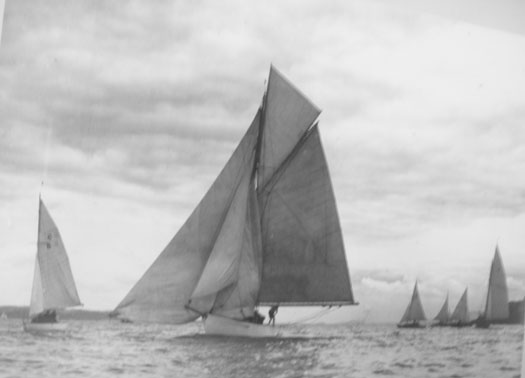
Lufra sweeps across the line to win the 1944 "Menagerie Race" at Ballyholme, and so become the first winner of the Lufra Cup. Photo courtesy Paul Finlay.
It was pursuit racing at its best, as close astern was one of the 30ft LOA Belfast Lough Stars (near sisters of the Dublin Bay 21s, but setting a gunter mainsail instead of gaff with tops'l) and then the rest of the fleet were in within minutes. The handicapper who'd set the starting times was delighted. But some Bay Class types weren't quite so chuffed, and suggested that as Howard Finlay had presented the new cup, the right thing to do would be to hand it on to the boat which finished second. He told them very precisely what they could do with that notion.
Over the next few years, Lufra was in the frame now and then, though the handicapper made sure she never won her cup again. But by the 1950s she was becoming very expensive to run, and in those recessionary times, she was unsellable. In fact, her lead ballast keel was worth more than the boat complete. So the keel was removed and sold, and this most handsome boat was laid up afloat in the little quarry hole harbour in Donaghadee in the hope that the good times would return. But for Lufra, the good times never did return. She rotted and sank, and when the quarry hole was being excavated to become Ireland's first coastal marina in the late 1960s, the last surviving relics of "the fleetest hound in the North" were dredged up and taken away to a landfill.
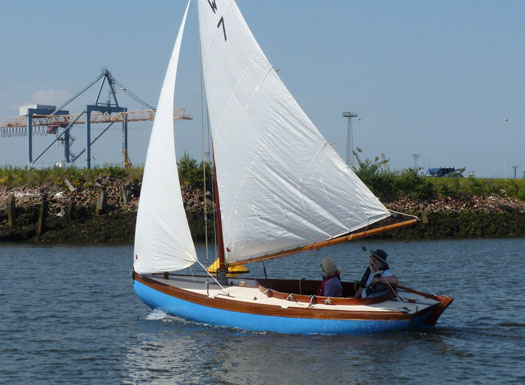
The restored 1903-built Belfast Lough Waverley Lilias (Jeff & Janet Gouk) was the 2011 winner of the Lufra Cup. Photo: W M Nixon
Yet the Lufra Cup lives on, and the list of its winners gives us a spare yet eloquent account of the sailing story at Ballyholme. Most appropriately, in recent years some of the winners of this trophy honouring Walter Scott's "fleetest hound in the North" have been boats of the old Waverley Class, now undergoing revival with impressive restoration projects. And years ago, when I was battling with racing Insect and Swallow class boats at Ballyholme, a frequent winner was a boat like a big sister of Lufra, Harry Townsley's 15-ton gaff cutter Anolis, which could go like a train on a reach in the kind of race Olympic idealists might sniff at, yet it was exactly what the punters wanted.
The winners over the years have included everything from a Laser (1993, and again in 2007, when sailed by Puppeteer designer Chris Boyd) to 1720s, with just about every type in between, and up or down too. I don't think an Optimist has ever won it yet, so current top cruising man Ed Wheeler has held the record for smallest winning boat since 1958, when he took the cup with his International Cadet.
Many of today's junior sailors may know little of the Cadet, though it still sails. Basically, it was a pram-bowed 10ft chine dinghy built (usually as DIY) in ply to a design by Jack Holt, who later designed the Mirror. The concept of the Cadet was as a mini-version of grown up racing dinghies, a proper training boat with a Bermudan rig which benefited from fine tuning, and setting a spinnaker.
But they were so very very small. The great Wic McCready, Northern Ireland's top junior sailor in his day, was a big lad who grew quickly. In his final year racing Cadets, in light weather he might be seen reposing with as much comfort as he could find by sticking his feet out over the stern. So when you saw a Cadet with Anolis thundering up astern and the finish line just feet away, it was very much little and large. As Ed Wheeler recalls it, crossing the line with Anolis's battering ram bowsprit right above your head concentrated the mind something wonderful.
So with the popularity of racing such as that provided for all ages in cruisers by Dublin Bay SC, and the golden thread of the Lufra Cup pursuit race at Ballyholme, it seems to me that maybe we're fulfilling many of the Ken Read objectives in Ireland already. As to setting unorthodox courses sometimes with pier starts, here in my own home port of Howth the 116-year-old Howth 17s were for a time strait-jacketed into Olympic courses which were much less stimulating than their time honoured courses in the interesting waters in and around Ireland's Eye, with handy pier starts just a few minutes sail from the anchorage, instead of having to sail for miles in search of the committee boat.

The Howth 17s sweep along in style after making a pier start during the 1930s. Having been making pier starts since 1898, there were attempts after 2000 to get them to use Committee Boat starts. But these days they find that a pier start, with the line only a very few yards from the harbour anchorage, is the option preferred by most crews. Photo: W N Stokes
The result is a revival of Howth 17 racing, particularly in the amorphous area of Saturday afternoon racing, when modern life presents too many distractions and other duties to people who would otherwise be sailing. The convenience and charm of handy starts and racing in very inshore waters seems to have spread, and the word is that the SailFleet J/80s, which will be based in Howth again this year, would also like some convenient pier-starting races in their programme.
So maybe we're going to reach the stage of Olympic sailors being told that they're welcome to keep their sterile starts, and windward-leeward courses far from land, the rest of us prefer a different emphasis. Except, of course, that at the 2012 Olympics, for the final races the fleets were brought very close inshore to facilitate spectators at Weymouth.
It seemed like a case of the tail wagging the dog. And if the racing had been continued offshore, with clear winds and plenty of it, Ireland might well have come home from the 2012 Olympics with a Sailing Bronze. So maybe the real message is, let's make sailing more fun...........except for the Olympics.
Ireland's West Coast – Special Boats & Big Hearted Sailors
#historicboats – These days we're told of the growing disparity between the economic recovery of Ireland's eastern region, and the relative economic stagnation of some of the rest of the country. But W M Nixon suggests that, for one part of the western seaboard at least, there's a special vitality to life around boats which challenges this perception, and could usefully be emulated elsewhere. And he signs off with a thought-provoking conclusion.
Connemara, Conamara. Spell it as you wish, but The Land of the Sea on Connacht's most westerly coast fires the imagination and inspires the spirit. It's a place of the mind as much as a place of wild mountains where rocky inlets wind their way deep into rugged country. So while purists might define it exclusively as the much intertwined coastline with its myriad islands between Spiddal and Killary, many of the rest of us can be so inspired by that special Connemara quality that we reckon it runs all the way from Galway Bay to Achill. And anyone from that magic coastline, or indeed anyone who has been inspired by it, carries the spirit of Connemara with them wherever they may be.
The boat people you meet out there, each with their own unique and often ambitious maritime agenda, will send you on your way re-enthused about boats and places and their many possibilities. And when someone from another place or indeed another country decides that it's in Connemara their true self and fulfilment is to be found, far from being seen as exiles they are instead seen as a new focal points for their old groups, and their soul-mates from times past descend on them in Connemara for inspiration and mental re-birth.
This weekend, the boat men from Clondalkin in outer Dublin are journeying to Renvyle on the furthest far west coast to help one of their own in his boat restoration programme at a storm-battered corner on a bit of coast which was almost washed away in the winter's seemingly endless climatic violence.
The men of Clondalkin are the community group who built and sail and continue to lovingly maintain the large Galway Hooker Naomh Cronan. Recently, they've been busy enough with replacing some planks on their hefty big boat. But their key organiser Paul Keogh is mindful of the fact that one of their own, Paddy Murphy, is in the west, living on an Atlantic point out beyond the old Oliver St John Gogarty house which is now the hotel at Renvyle.
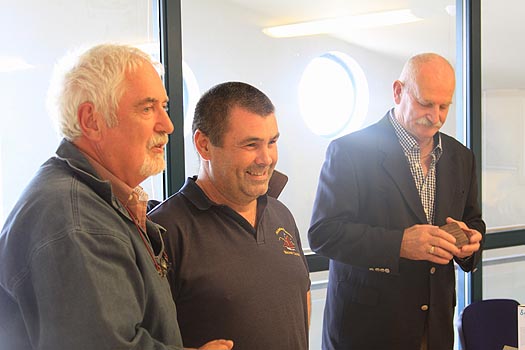
They dreamed the dream, and they made it happen. Key movers in the Naomh Cronan story were Stiophan O Laoire (left) and Paul Keogh, seen here at Poolbeg Y & BC as they come forward to accept a prize on behalf of the crew from Johnny Wedick, Hon. Sec. of the Dublin Bay OGA. Photo: Dave Owens
And between Paddy's house and the sea, beside a little hidden slipway which serves small boats which undertake the risky but rewarding challenge of harvesting Ireland's most fish-filled waters, the restoration project on the Aigh Vie is proving to be a demanding task. So this weekend the Keogh team – precise numbers unknown until everyone checks in this morning – are on site to re-caulk the Aigh Vie in a wild weekend of communal energy.
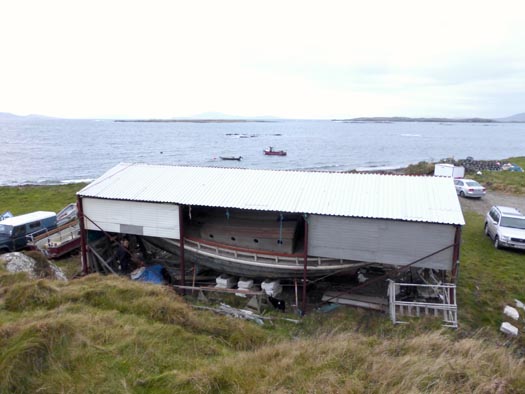
On the Atlantic frontier at Renvyle, the Aigh Vie is under her roof, tilted over to port to facilitate work under the starboard side of the hull. Photo: W M Nixon
For the Aigh Vie is one very special vessel. She's one of the Manx fishing nobbies which reached their ultimate state of development in the first twenty years of the 20th Century before steam power and then diesel engines took over. The nobby evolved to an almost yacht-like form through vessels like the 43ft White Heather (1904), which is owned and sailed under original-style standing lug rig by Mike Clark in the Isle of Man, and the 1910 Vervine Blossom, now based in Kinvara, which was restored by Mick Hunt of Howth, but he gave her a more easily-handled gaff ketch rig which looked very well indeed when she sailed in the Vigo to Dublin Tall Ships Race in 1998.
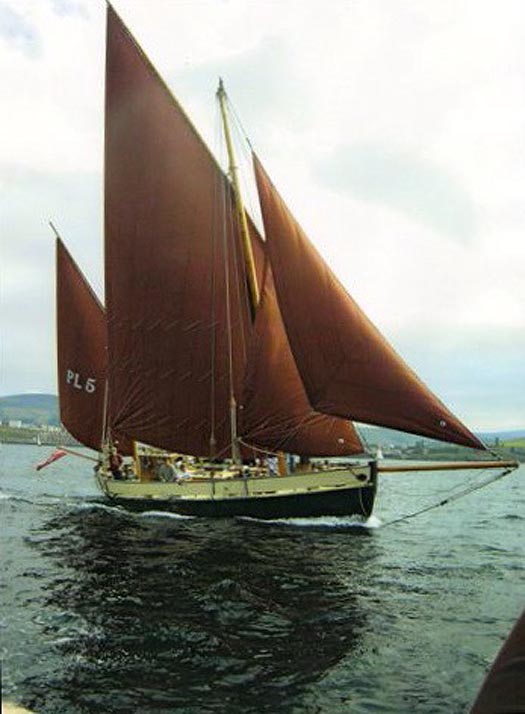
Mike Clark's Isle of Man-based 1904-built Manx nobby White Heather sets the original standing lug rig.
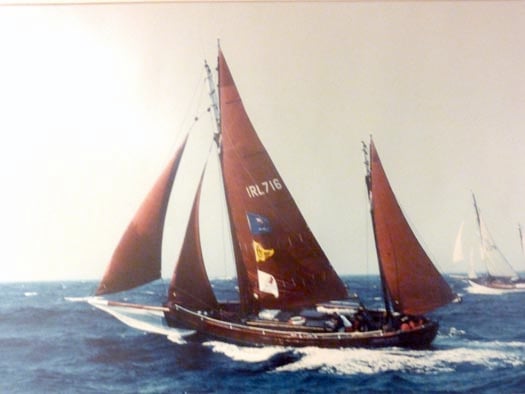
The 1910-built Manx nobby Vervine Blossom was restored by Mick Hunt in Howth, and is seen her making knots under her gaff ketch rig at the start of the 1998 Tall Ships Race from Vigo to Dublin. Photo: David Branigan
It takes quite something to outdo the provenance of these two fine vessels, but the story of Aigh Vie (it means a sort of mix of "good luck" and "fair winds" in Manx) is astonishing. It goes back to the sinking of the Lusitania by a German U Boat off the Cork coast in May 1915, when the first boat to mount a rescue was the Manx fishing ketch Wanderer from Peel, her crew of seven skippered by the 58-year-old William Ball.
They came upon a scene of developing carnage. Yet somehow, the little Wanderer managed to haul aboard and find space for 160 survivors, and provide them with succour and shelter as they made for port. In due course, as the enormity of the incident became clear, the achievement of the Wanderer's crew was to be recognised with a special medal presentation. And then William Ball, who had been an employee of the Wanderer's owner, received word that funds had been lodged with a lawyer in Peel on behalf of one of the American survivors he'd rescued. The money was to be used to underwrite the building of his own fishing boat, to be built in Peel to his personal specifications, and the result was his dreamship, the Aigh Vie, launched in 1916.
Over the years, the Aigh Vie became a much-loved feature of the Irish Sea fishing fleet. Tim Magennis, current President of the Dublin Bay Old Gaffers Association, well remembers her from his boyhood days in the fishing port of Ardglass on the County Down coast. In time, she was bought by the legendary Billy Smyth of Whiterock Boatyard in Strangford Lough, who gradually converted her to a Bermudan-rigged cruising ketch with a sheltering wheelhouse which enabled the Smyth family to make some notable cruises whatever the weather. His son Kenny Smyth, who now runs the boatyard with his brothers and is himself an ace helm in the local 29ft River Class, recalls that the seafaring Smyth family thought nothing of taking the Aigh Vie to the Orkneys at a time when the average Strangford Lough cruiser thought Tobermory the limit of reasonable ambitions.

Aigh Vie as she was when bought by Paddy Murphy from Billy Smyth of Strangford Lough.
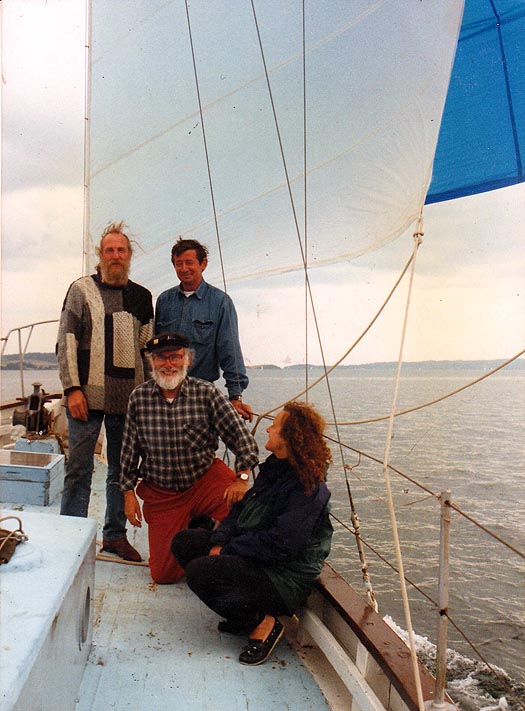
First sail with the newly-bought ship. Aboard Aig Vie heading for Dublin down Strangford Lough, the crew includes Paddy Murphy (left) and Tim Magennis (centre)
It's some years now since Paddy Murphy bought the Aigh Vie, and sailed her back to Dublin with his crew including Tim Magennis. But around the same time, Paddy was moving his base west to Renvyle, where he reckoned his skilled trade as a blacksmith, and his talents in traditional music and folklore, would provide him with a living in the area where he felt most at home.
As for the Aigh Vie, clearly she was reaching an age where work needed to be done. And he was minded to restore her to something more nearly approaching her original 1916 configuration. So somehow or other, he took the big boat west on a truck, managing to negotiate those little winding roads through Tully Cross and down to his place by the sea, where she went under a roof and work began.
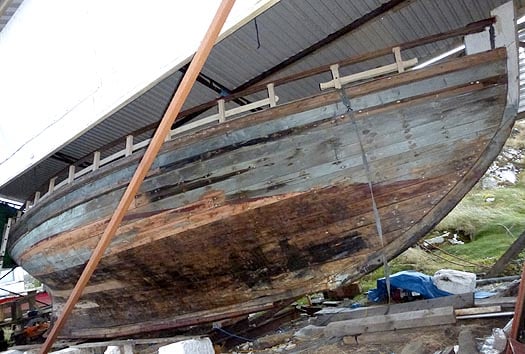
The hull of the 1916-built Aigh Vie as seen in Renvyle shows the remarkably yacht-like lines of the Manx nobby.........Photo: W M Nixon

.........in what was one of the last of the sailing type to be built before steam power took over. Photo: W M Nixon
It has been going on for some time now. The problem with being right on the frontier of Ireland's Atlantic weather is that no sooner do you start on some new area of timber repair and replacement, than the previous restoration section almost immediately starts to become weathered. Working largely on your own, you end up feeling you're going round in circles. So that's why the men from the Naomh Chronan are in Renvyle today to give the Aigh Vie project a mighty push forward.
For there's no doubt that while there's a lot done, there's a lot more still to do. But it does get done eventually if you keep the faith, and I was there back at the beginning of December to cheer Paddy along with all the usefulness of a hurler on the ditch. But at least I was accompanied by Dickie Gomes, who knows a thing or two about long-term boat restoration, as it took him 27 years to bring his 102-year-old Ainmara successfully back to life. But he did it so well that she won the Creek Inn Trophy for "Best in Show" at last summer's Peel Traditional Boat Weekend in the Isle of Man.

A bit of mutual support between two owners of vintage wooden boats – Paddy Murphy and Dickie Gomes in Aigh Vie's shed at Renvyle. Photo: W M Nixon
Nevertheless I've to confess that sometimes I wonder if wood is worth the trouble. Before getting to Renvyle, we'd called by with Jamie Young at Killary Adventure Centre for bit of a love-in with his alloy-built Frers 49 Killary Flyer which - as Brian Buchanan's Hesperia IV - was winner of the Round Ireland Race 1988 under the command of Dickie Gomes. Except that you won't see that fact in histories of the Round Ireland. Because for 1988's race, she sailed as the sponsored entry Woodchester Challenger, and thus was not entitled to the top prize, despite having the best corrected IOR time in the fleet.
But everyone in the know knows that Gomesie won, particularly the crew of Denis Doyle's slightly larger Frers sloop Moonduster. The two boats had been neck and neck running past the Blaskets, and suddenly Hesperia's spinnaker shredded. But Dickie had his crew so well drilled that one half of them had a replacement chute up and drawing before the other half had finished getting in the remains of the torn sail. The boat scarcely missed a beat in her rapid progress, and when the whole business was completed in about three minutes flat, there was a round of applause from Moonduster. You'd sportsmen doing the Round Ireland in those days.
As it happens, one of Hesperia's crew for that neat bit of work was Kenny Smyth, so it made it more than appropriate that we were going on to see the Aigh Vie on which he cut his offshore sailing teeth. But it was good to linger for a while at Jamie's snug place, and marvel at how he, with aid from the ingenious folk of the west, had contrived a slip and an angled trolley so that Killary Flyer can be hauled on site into a sheltered corner, for she's a big lump of a boat to be handling ashore.
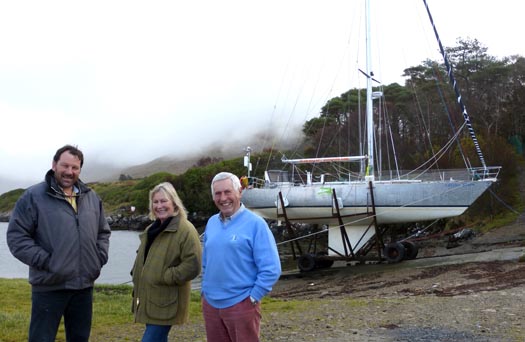
She's a big boat to be hauling on a slip in a remote corner of Mayo. Early December beside Killary Fjord, and Jamie Young of the Adventure Centre with Deirdre and Dickie Gomes and the Frers 49 Killary Flyer ashore for the winter. Deirdre was a fulltime member of the boat's crew when Dickie successfully skippered her offshore as Brian Buchanan's Hesperia IV. Photo: W M Nixon
It was some time in the New Year that we heard the shocking news. One of the most severe storms had twirled the Flyer up like a toy boat from her sheltered corner, and deposited this Frers masterpiece on her ear. Jammed in against the steep shore, she was trapped as the tide came in, and the hull was flooded with severe damage to the electrics and electronics.
But this is the west, where they're accustomed to overcoming massive challenges. The extraordinary Tom Moran of Clew Bay Boats played a key role in a salvage project which saw a temporary road being built so that a giant crane could be positioned for the delicate job of inching the big boat back upright. That done, she could then be moved to Tom's place at Westport for restoration to begin.
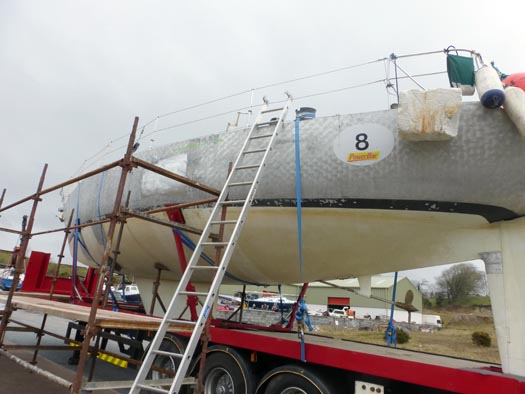
A couple of dents in aluminium? No problem. Following her brief episode of aviation, Killary Flyer's hull is already made good at Clew Bay Boats in Westport. Photo: W M Nixon
The whole business has been a marvellous advertisement for the effectiveness of hull construction using modern marine alloys. When aluminium was first created as the "Metal of the Future" two centuries ago, only the Emperor Napoleon could afford to have a cutlery set made in this exotic stuff. And though an early alloy boat put afloat in Lake Geneva performed reasonably well, as soon as a boat built with it was put into the salty sea, it just melted away.
But over the years the formulas have been adjusted to be corrosion proof in sea water, such that nowadays it's the ideal material for little boats which are going to have hard usage yet little maintenance, such as angling boats and the nippy craft used by rowing coaches.
And if you have a low-maintenance alloy hull yet give it a bit of cosmetic attention, it will look very well indeed, but it's not essential. As for the rough and tumble of life afloat, if you crash into a quay wall with a traditionally built wooden boat, she'll become shook from bow to stern – you never really know where the underlying structural damage ends, if at all. As for GRP and carbon or whatever, the damage will be more localised, but it still gets holed, and messily with it at that, while bulkheads may shift to an unknown degree
But a steel or aluminium hull will generally just be dented, and very locally at that. Repairs are manageable, even if it's skilled specialist work. So there's a lot in favour of steel and alloy. But steel rusts, and it never rusts quicker than in hidden pockets in the structure. But with remarkable advances in alloy welding and building techniques, the advantages of modern corrosion-free alloy construction become more evident every year for boats that are really going to be used, and not just seen as marina ornaments.
The Killary Flyer experience is ultimately a telling argument in favour of alloy construction. The hull was only dented in a couple of places where it was actually in direct contact with outcrops on the foreshore. Any dents have already been repaired by Tom Moran and his team, for they're able for anything to do with boats in any sort of material - I reckon if you wanted to build your dreamship out of resinated peat moss, then Tom would be game for the job.

Can-do people of the west – Mary and Tom Moran of Clew Bay Boats have successfully taken on many marine problems and projects. Photo: W M Nixon
Sorting out the interior systems is going to be more of a challenge, for Hesperia was originally Noryema X, built for Ron Amey in 1975. In a sense, there's a feeling of homecoming in the fact that she's being restored in Westport. If you head directly inland from that lovely little town, you're soon up in the mountains in the Joyce Country. And way back in 1975, the alloy hull of Noryema X was built by the renowned Joyce Brothers. Their fabrication workshop may have been in Southampton, but the family wasn't that long out of the mountains of far Mayo.
However, once the innovative Ron Amey had taken delivery of the hull of his latest Noryema from the brothers Joyce, he then took it to Moody's big shed at Bursledon on the Hamble for completion by the boatyard's craftsmen. I happened to be Bursledon-based in the early summer of 1975, and it really was all a wonder to behold.
Amey had installed a caravan in Moody's shed, and he lived in it while overseeing every detail of the new boat's fitout, while at the same time running his business empire of Amey Roadstone from a telephone in the caravan. It was said that the great man wouldn't be really happy with his new boats until the final jobs were completed just before the Fastnet Race in August, and after that he'd then start to think of the next one. But Noryema X was something special. She became the last of the racing line, and despite her enormous rig, Ron Amey then used her for eleven years of cruising in the Mediterranean which concluded with her sale to Brian Buchanan of Belfast Lough at Marseilles in 1986. She has been based on our island ever since, the source of much seagoing pleasure for hundreds of Irish sailors.
So bringing her back up to Amey standards is quite a challenge, as she's now part of Ireland's sailing heritage. But with Tom Moran they've someone who seems to have links with every maritime specialist in the country, and if he draws a blank in Ireland, his connections around the Solent marine industry seem pretty hot too.

Not quite where you'd expect to find an Arctic voyaging vessel, but Northabout seems at home in the Moylure Canal in the midst off Mayo fields. Photo: W M Nixon
Much encouraged by all this, for Clew Bay Boats is the sort of place where many good things seem possible, we then headed down to the Moylure Canal, a drainage waterway near Rosmoney at the head of Clew Bay where the great Jarlath Cunnane has created a tiny boat harbour and beside it a little place where, if so minded, he can build himself a boat.
Jarlath is the quintessential Connacht mariner, yet you'll never find him being sentimental about wooden boats. On the contrary, in the time I've known him he has built himself a steel van de Stadt 34ft sloop which he cruised very extensively, and more recently he took on the challenge of alloy construction to build the 44ft Northabout. Aboard this special boat, in teamwork with Paddy Barry, he has made cruises to remote and challenging places in voyages which, for most people, would have required full military logistical support.
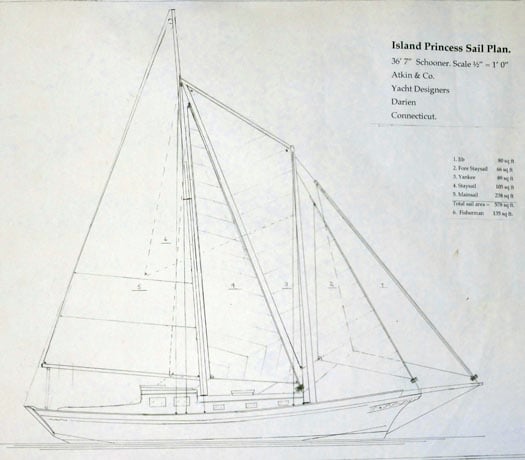
The new dreamship. Plans of the 37ft Atkins schooner which Jarlath Cunnane has been building over four years.
Knowing the scale of what he has done with her, it was bizarre to see Northabout sitting modestly in her berth in the little creek beside a Mayo field. But the presence of the long distance high latitude voyager was only part of the Moylure package. A few feet away in "the shed which isn't really a shed" was the new Cunnane boat, a sweet 37ft–Atkins schooner which, if you haven't yet appreciated the potential of good alloy boat construction, would surely win you over in a trice.

Good alloy construction, as seen here in the stemhead of the new schooner, can withstand comparison with any material. Photo: W M Nixon
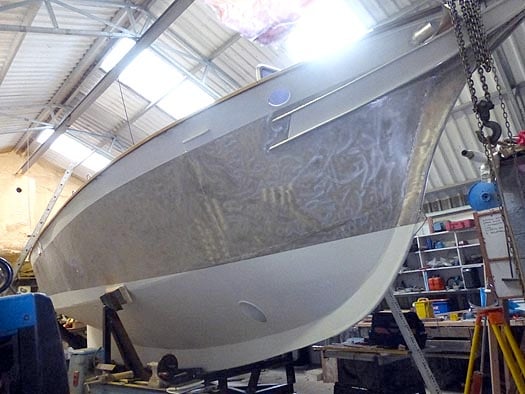
The new schooner has a workmanlike and handsome hull......Photo: W M Nixon

....which is aimed for comfort as much as speed, but she should be able to give a good account of herself in performance, and will be very comfortable for longterm periods on board. Photo: W M Nixon
Jarlath has taken four years on the construction, and when he gets to sailing the new boat, I'd say that the motto will be: "When God made time, he made a lot of it". This is a boat for leisurely cruising, a boat to enjoy simply being on board. In her finished state, she'll give little enough in the way of clues as to her basic construction material. Like Killary Flyer, and like Northabout too, she is in her own way a great advertisement for the potential of good alloy construction.
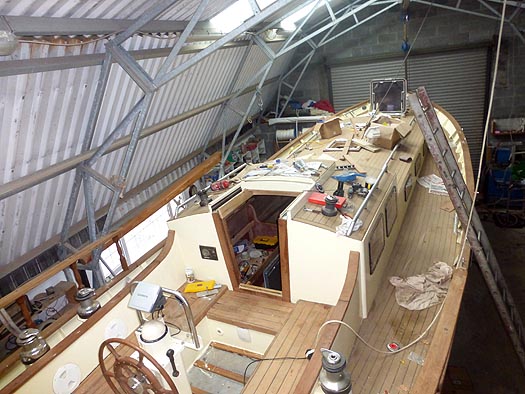
As completion nears, it becomes ever less apparent......Photo: W M Nixon
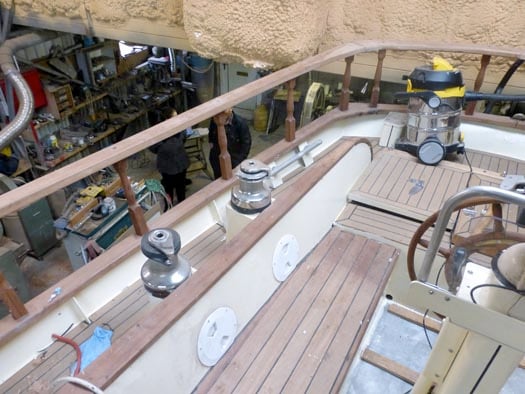
.....that the hull construction of the new schoner is in aluminium. Photo: W M Nixon
So we'll sign off this week with a special thought. As Irish life begins to move again, doubtless we'll soon hear increasing mutterings about the desirability of building a new Asgard sail training brigantine. Maybe we should keep the government out of it this time round, and build her through a voluntary trust organisation supported by public subscriptions and corporate donations. But however it's to be done, we should be starting to think about it.
And like many others, I've long thought that the ideal way forward would be with a steel hull built to Jack Tyrell's original Asgard II lines, which have a magnificently timeless quality to them. But I've changed my mind on that. Having seen what can be done with good alloy construction down in Mayo, and knowing the quality of alloy workboat construction being produced by firms like Mevagh Boatyard in Donegal and by the descendants of Jack Tyrrell among others at Arklow Marine Services in County Wicklow, it's difficult to escape the conclusion that the hull of the new ship should be built in aluminium.
It would be initially expensive, but it would confer great longterm maintenance advantages. And by going that way, we'd be able to provide all the double skins and safety bulkheads which will now be required without using up all available hull space, and without producing a boat so heavy she wouldn't be able to sail out of her own way. So let's hear it for an aluminium-hulled Asgard III.
#eastcoastports – Ireland's east and north coasts may lack the cruising glamour of the south and western seaboards, but W M Nixon suggests that the ICC's East & North Coast Sailing Directions points the way to an area with its own special charms. And he ponders a coastal mountain-measuring quandary in this blog first published in March 2014.
Now here's a thought. Could it be that Scrabo, the tower-topped hill which dominates the northern waters of Strangford Lough, is not as high as officially reckoned? Could it be that its recognised height of 538ft (which doesn't include the 125ft height of the tower itself) is a bit optimistic?
Such notions come from contemplating aspects of the new 12th Edition of the Irish Cruising Club's Sailing Directions for the East & North Coasts of Ireland, which is now on sale at £29.95 or €37.50. It's worth every cent, not just for those planning to cruise the area, but simply if you sail from any of the ports covered. And the interest lies not just in the essential information conveyed for safe navigation and pilotage along these many miles of varied coastline, but also in the implications of that information in a larger context.
As the ICC publishes two books with the most recent massive 13th edition of its best-selling South & West guide appearing last year, inevitably people will compare the two areas. And equally inevitably, the east coast can appear a rather humdrum sort of place by comparison with the lotus-eating charms of the south coast, and the spectacular glories of the west, while the north coast sometimes seems just too challenging to be contemplated at all. However, in one category the east and north coasts put the south and west coasts in the ha'penny place. The eastern and northern seaboards are absolutely tops in tides.
On the west and south coasts, apart from the Shannon Estuary and maybe Achill Sound and perhaps Cork Harbour entrance at Springs, tidal streams are relatively weak on the entire coastline going westabout between Hook Head in Wexford and Bloody Foreland in Donegal. And yes, I too have shot the tidal rapids at Lough Hyne, but that's a special case. Otherwise, it's useful to have the tide with you along the coast, and it's best to avoid wind-over-tide at major headlands. But generally, unless you've a long passage planned you can come and go at sociable hours for day sails rather than having your schedule dictated by tide.
Yet if you're voyaging that same journey from Ireland's southeast corner to the far northwestern extremity via the east and north coasts with the absolute shortest distance being 282 miles, the tidal streams are dictating your times of coming and going except between Skerries and Ardglass on the east coast, and west of Malin Head on the north. Elsewhere, it's conveyor belt coastline, and anyone sensible will go with the flow.
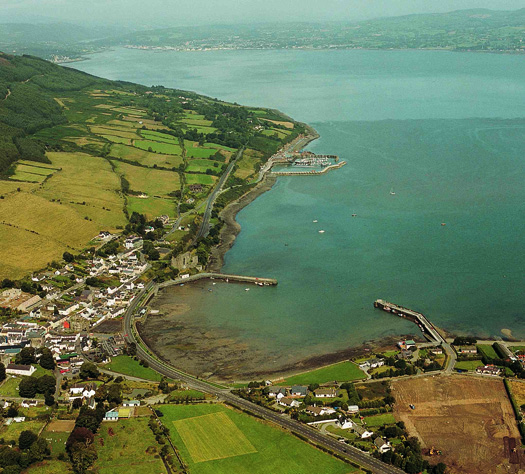
Carlingford Lough is one of several inlets on these coastlines whose narrow entrances have strong tides. The mediaeval little township of Carlingford has its own largely drying harbour (foreground), but the marina further along the shore is accessible at all states of tides, and has facilities on site. However, village waterfront hospitality resources are somewhat spread out, as the hospitable Carlingford Sailing Club (extreme right), with its own slipway and welcoming clubhouse, is at a significant distance from the marina. Photo courtesy ICC/Kevin Dwyer
In addition, where natural harbours and sheltered inlets exist, in a surprising number of cases on the east and north coasts the entrances are narrow, and pushing the tide to get through can be a serious challenge. This is the case in Mulroy Bay, Lough Foyle, Larne Lough, Strangford Lough and Carlingford Lough. But the great inlets of the west, particularly the magnificent rias of the southwest, are drowned river valleys which close in only gradually, resulting in much gentler tides.
Strangford Lough's entrance by contrast is totally tide-dominated, and many local cruising boats solve the problem simply by never leaving the place. But as a study of this new book (yet another extraordinary effort from the ICC's remarkable sailing directions team of Norman Kean and Geraldine Hennigan) successfully reveals, Strangford Lough is indeed a wonderful world unto itself, and you could happily cruise here for a week without feeling the need to venture into the dark unknown to seaward beyond The Narrows, where the tides hit 8 knots and more, and the whirlpool of the Routen Wheel waits to trap the unwary.
It's the business of the sea pushing in and out Strangford Lough twice a day (and generating electricity while it does so) which provokes the thought that maybe Scrabo is not as high as generally thought. The hill is simply known as Scrabo, which sounds like somewhere in Transylvania – it could be Dracula's summer residence - but apparently it means nothing more exciting than "cow pasture" in Gaelic. They were hardy cattle in them days, as it can be rugged enough on top, for Scrabo's location relative to the serene inner reaches of Strangford Lough emphasises its exposed nature.

Strangford Narrows, with a smooth yet powerful stream, though it can be anything but smooth when it meets open water and an onshore wind. The tides in the Narrows provide so much guaranteed energy that they have been harnessed by this generator to provide sufficient electricity for a thousand homes. Photo: courtesy ICC
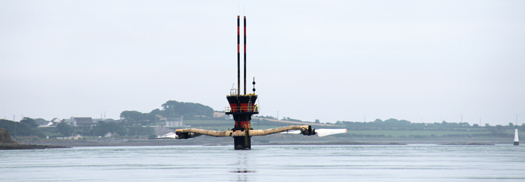
The Seagen tower with its turbines raised clear. Like this, it can be a hazard for sailboats passing too close. Currently, the scorecard reads: Seagen-1, Yacht Masts-0. Miraculously, no-one was hurt. Photo courtesy ICC.
But the point is that high water in those remote inner reaches and in Strangford Lough generally occurs a clear two and a half hours after high water in the Irish Sea. Thus down at the Narrows, the water may be still pouring into the lough, yet out in the Irish Sea the tide has peaked, the ebb is running north, and the sea level has been falling for a good two and a half hours by the time the final surge has reached the top, way up at the flat shore below Scrabo.
So it occurs to me that, could we but somehow measure by the most precise methods exactly from the centre of the earth, then mean sea level at Scrabo would always be less – maybe even a metre less – than on the ocean generally. And for all hills, whether it be Scrabo or Everest or whatever, the height above sea level is the gold standard. So the surface of the sea must curve over and above the curvature of the earth.
My ignorance of modern surveying methods being almost total, doubtless this idle speculation will bring down scorn, and we'll find that crude measures of sea level by observation at a local position have been long since superseded by more scientific techniques. Probably these days sea level has little enough to do with the level of the sea. But if you're someone who likes to muse on such things as the true height of Scrabo in the light of Strangford Lough's wayward tides, then you've the mind of a cruising person, and you'll find the new guide a delight, particularly if you reckon the east coast has been getting a raw deal in the perception stakes.

The Economic Corridor. Dublin Port looking seaward at a quiet period between ship movements, which currently run at 40 per day. Grand Canal basin is bottom right, while the ancient maritime community of Ringsend is just across the River Dodder. The Dodder's east bank, now lined with corporation flats, used to be a hive of activity with at least four boatyards on the foreshore. Poolbeg Y & BC marina is beside Roingsend. Photo courtesy ICC/Kevin Dwyer
That said, it has to be admitted that between Dublin and Belfast, the "East Coast Economic Corridor" may sound glamorous to business folk, but it can make it all seem rather workaday to the rest of us when sailing the nearby sea. Then too, the dictation of the tide in setting the times of your passage-making gives a sense that you're commuting along the coast, rather than cruising it. Finally, while there may be several handsome ranges of hills and mountain along both coastlines, only in certain areas is there significant indentation of the coastline to give that air of excited anticipation as to what might be round the next corner. By contrast in the south and west you've many variations on the sense of anticipation exemplified by the always uplifting experience of coming northwards through Dursey Sound and suddenly seeing the entire panorama of the Kerry mountains revealed in all their purple glory.
But living in such a state of constant excited anticipation would be damaging for anyone's health. The real business of life is making the best of the hand you've been dealt, and these days the east and north coast deal is much enhanced by greatly improved harbours and marinas. These make for much more convenient access to port towns, which in their turn provide a better hospitality package which adds greatly to the enjoyment of a day's sail along a coast which may have been looking very well indeed.
Not least of the factors in this is that, along the east coast at any rate, it rains less than on Ireland's other coastlines. Sometimes a lot less. And it's at its best when the wind is the Atlantic breeze, the westerly off the land. When "the wind is off the grass", as the crewmen in the Irish Lights vessel describe their ideal conditions for working at buoys and other navigation aids, then sailing Ireland's east coast is very pleasant indeed.
Although the east coast officially begins at Carnsore Point, the ICC Directions sensibly begin just round the corner at Kilmore Quay, whose transformation by Wexford County Council into a useful sailing/fishing harbour has greatly changed everyone's perception of the area. And just to show that the Saltee Islands can now be seen at the very least as an interesting day cruising destination from Kilmore itself, the book includes a useful photo of the fair weather anchorage on the southeast coast of the Great Saltee.

In times past, the Saltee Islands were seen by cruising folk as somewhere to get past as quickly as possible. But now that there's a fine little all-weather harbour and marina at Kilmore Quay, this photo of the fair weather anchorage off the southeast coast of the Great Saltee is of special interest. Photo courtesy ICC.
Heading up the east coast, the favoured first port of call tends to be Arklow, where developments in recent years have been an intriguing illustration of the way Ireland is administered. In any rational society, you'd have expected the Arklow Basin on the south side of the river – which has the benefit of having an exceptionally small tidal range – to be re-developed as a modern recreational harbour, a sort of Irish Honfleur.
But of course any attempts at this sensible line of action were stymied by inertia and entrenched interests, so the get-up-and-go section of Arklow society simply got on with things on the north side of the river. There, a marina has been developed in a new basin, and what amounts to a new township shows every sign of developing alongside it, while across the river the old basin slumbers on.

Arklow is home to an ancient seafaring tradition, manifested itoday in a vibrant locally-registered merchant fleet which operates internationally. The new harbour and waterfront development on the north bank of the river (left) proceeds crisply ahead while the old Arklow basin on the other side ponders it future. Photo courtesy ICC/Kevin Dwyer
Undoubtedly the most exciting development on the east coast in recent years has been the creation of an all-weather harbour at Greystones, within easy sailing distance of Dublin yet just far enough to provide a sense of achievement. And there's a certain extra satisfaction in enjoying your breakfast aboard a cruising boat in the new marina while the commuter-filled DART trains trundle past headed towards the city, yet beyond in the morning sun the Wicklow hills look more beautiful than ever.

"Good morning, Greystones, how are you?" Breakfast on a cruising boat never tastes better than when you're in the new Greystones Marina with the early sun on the Wicklow hills, and a DART train filled with commuters heads for Dublin. Photo courtesy ICC
With the coastal developments of the last twenty to thirty years, the east and north coasts have now been reborn as sailing and cruising areas with the two main yacht harbours at Dun Laoghaire and Bangor, while there are now medium size marinas at Greystones, Poolbeg in Dublin, Howth, Malahide, Carlingford, Carrickfergus, Glenarm, Ballycastle, and Fahan on Lough Swilly.
Additionally there are the key smaller facilities at Arklow, Warrenppoint, Ardglass. Portaferry, Belfast Harbour, Rathlin Island, the Bann Estuary, Derry/Londonderry and Rathmullan, while convenient landing pontoons have been installed at several other sites. Details on all these and much more can be found in the new ICC book, but anyone cruising the region develops fondness for some favourite spot, and as someone who has been cruising up and down these coasts for a while now, I have to say that the facility which has most transformed the cruising is surely the little marina at Ardglass, officially known as Phenick Cove.
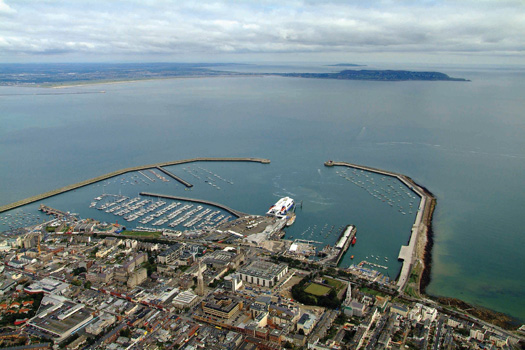
Kingpin harbour – Dun Laoghaire before the new "library" was erected at amazing speed in the middle of the waterfront. Photo courtesy ICC/Kevin Dwyer
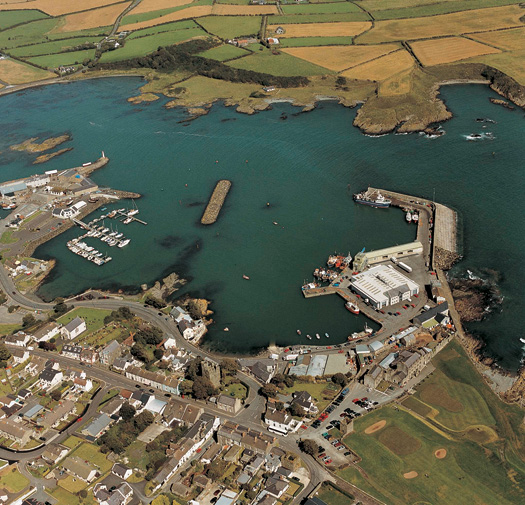
Ardglass. This little port has become one of the most useful of all, particularly for people who really do cruise. Photo courtesy ICC/Kevin Dwyer
It is just so conveniently located, you don't have to deviate at all from the direct course up and down Ireland's East Coast, and the welcome provided by marina manager Fred and his array of amiable animals is second to none. Quite how we managed before Ardglass marina was installed I don't know any more. But I think it involved far too many unnecessary nights at sea, whereas now you can have a convenient overnight in a quirky place where – if you're minded to eat ashore – you can ring the changes between one of the best Chinese restaurants on the coast, or else the golf club in the castle makes sailors more than welcome, and if you've had enough of the salty sea for a while, a very short taxi ride takes you into the utterly and very aromatically rural heart of the country and steaks at Curran's foodie pub.
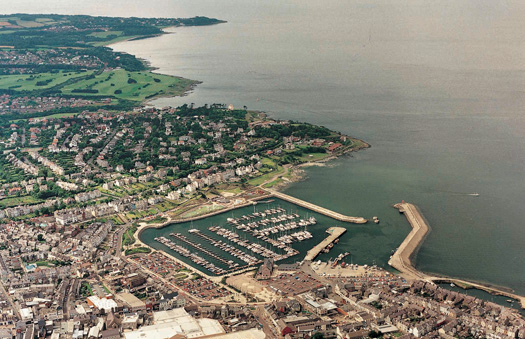
Bangor Bay's marina has settled in so well you could be forgiven for thinking the town was built around it. And you won't be surprised to learn that this part of North Down is known as the Gold Coast. Photo courtesy ICC/Kevin Dwyer
When these ICC Directions first appeared in book form in 1946, they covered only the east coast, and that only between Carnsore Point and the little harbour of Carnlough on the Antrim coast. In those days, there were few if any facilities for cruising boats beyond it on the Irish coast, so it was seen as the best jumping-off port for people headed for the more civilised cruising on Scotland's west coast.
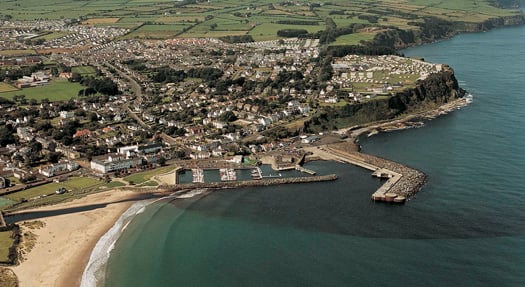
Ballycastle Harbour and marina required a king-size breakwater for full shelter, but its convenient location has been greatly beneficial for cruising the area. Photo courtesy ICC/Kevin Dwyer

Thirty years ago, the notion of Rathlin Island as a popular cruising destination would have seemed absurd, yet the provision of a harbour has brought about a welcome change, and in summer there are always at least several (and often many) cruising boats in port. Photo courtesy ICC.
So it's around Ireland's northeast corner that the changes have been most beneficial, with a proper harbour at Glenarm and –miracle of miracles – a real harbour at Ballycastle. It has had to be built as a really massive affair, for you're now on the rugged north coast, but it has opened things up to great benefit, as it's a short day sail from the Hebrides, the charms of Rathlin Island with its excellent little marina are just across the Sound, and with the pressure taken off to get to any old harbour with some short of shelter, you can explore the Antrim coast at your leisure. You come away convinced that the famous Carrick-a-Rede rope bridge looks even more spectacular when seen from sea, yet equally convinced by Dr Johnson's famous comment that while the Giant's Causeway may be worth seeing, it's not worth going to see.
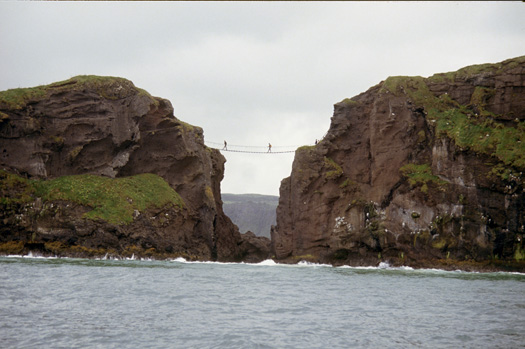
The north Antrim coast's famous Carrick-a-Rede rope bridge is best seen from a cruising boat. Photo: W M Nixon
Further along the north coast, there's excitement at Portrush as a 200 berth marina is planned for this key port. For anyone interested in harbour construction, it will be a fascinating project, for although Portrush is eastward of the most exposed point of all at Malin Head, it still manages to have truly ferocious sea conditions during winter storms. So the proposed new breakwater will have to be on mega-scale, but from a cruising point of view the provision of secure marina berths here will add an entirely new dimension. Portrush has direct rail connection with the rest of Ireland, and it provides the best departure port if you want to make a quick passage to the Outer Hebrides. A course from Portrush shaped to leave Skerryvore to starboard will take you neatly to Castlebay in Barra while leaving the inconvenient tides and turbulent waters of Islay well clear to the east, and the rough water north of Malin well away to the west.

Portrush as it is today. A plan for a 200 berth marina will necessitate an ambitious extension and reinforcement of the main breakwater. Photo courtesy ICC/Kevin Dwyer
But for anyone cruising on towards north Donegal, those demanding waters off Malin Head are part of the challenge, and plumb in the middle of them is storm-racked Inishtrahull. Amazingly, in the long distant past this little island supported several families, but these days its deserted state would make you wonder at the ICC book's assertion that there's quite a decent anchorage at Portmore on the island's hyper-rocky northern coast. So just to show that there is indeed an anchorage here, the book features a photo of Portmore with a fine cruising yacht serenely in the midst of it.
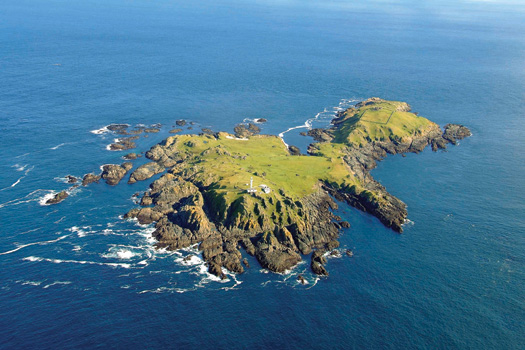
Remote Inishtrahull, most northerly part of Ireland. Yet there is an anchorage here..............
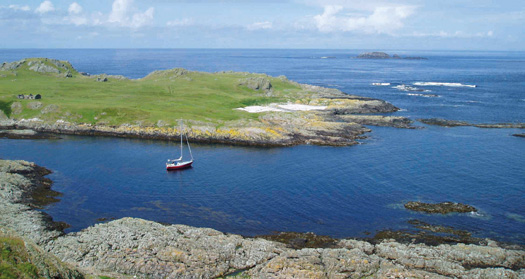
.....and the ICC book has the photo to prove it. Photos courtesy ICC/Kevin Dwyer/Ed Wheeler
West of Malin, the majestic north coast of Donegal includes the entrances to many inlets, the largest being Lough Swilly which is about the size of the Solent. The main sailing base is at the sandy creek at Fahan on the east shore where the provision of a marina brought expectations of proper well-planned shoreside supporting development to take the raw look off the place, but disappointingly it hasn't happened yet. We can only hope that the success of local sailor Sean McCarter as a skipper in the current Clipper Round the World Race will inspire the Fahan area to finish the job.
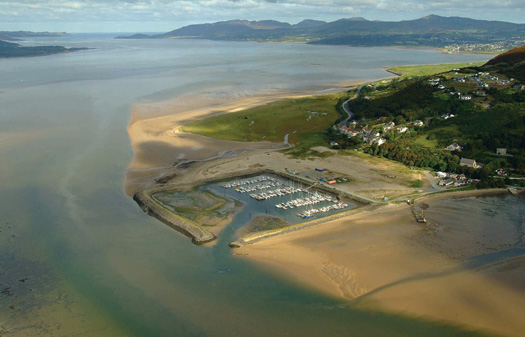
A job that really ought to be finished properly. The marina at Fahan on the east shore of Lough Swilly in Donegal is badly in need of appropriate shoreside development. Photo courtesy ICC/Kevin Dwyer
Further west, and its pure Atlantic, but relieved by remote and secure inlets. Nevertheless it's difficult to grasp that the secluded and forest-sheltered anchorage at lovely Ards on Sheephaven is only a very few miles from the storm-tossed rocks of Tory Island, but such is the case. At Camusmore on Tory, the tiny harbour seems to be hurricane-proof, for although it was in the most violently-assaulted of all areas on Ireland's west coast during the thirteen storms of the past rough winter, surprisingly Tory is not among the harbours listed for government largesse in the current tranche of funding for urgent repairs.
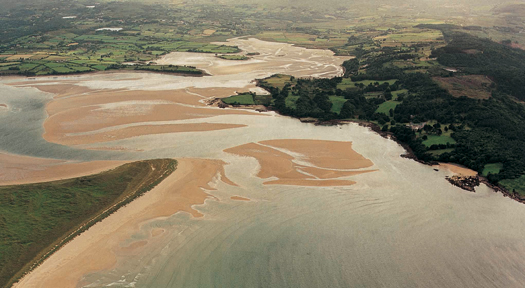
This snug tree-sheltered anchorage at Ards on Sheephaven does not accord with the popular perceptions of the rugged nature of North Donegal, yet here we see a lone cruising boat enjoying its gentle charms. Photo courtesy ICC/Kevin Dwyer
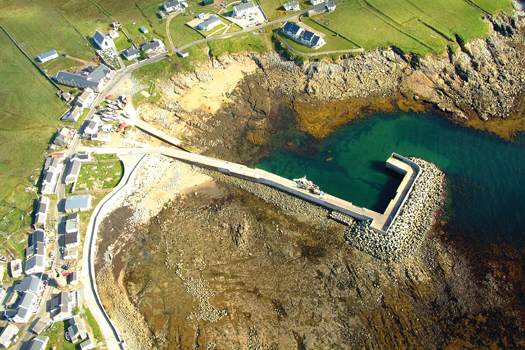
It's bullet-proof, it's hurricane proof – it seems there was no need for the little nugget of a harbour at Camusmore on Tory Island to apply for emergency funding for any urgent repairs despite the winter-long assault by at least thirteen different storms. Photo: Courtesy ICC/Kevin Dwyer
But Tory Island's nearest mainland quay at Magheraroarty is down for repair funding, and away to the far southeast at the crowded little harbour of Courtown in Wexford, they've a harbour which is down for more than €1 million in repairs expenditure. Courtown is a difficult one, a narrow little river port where life is a continuing struggle to keep the sand at bay, and yet stop the quay walls from being undermined. When you see what they had to do at Tory and Ballycastle to keep their harbours in place, you can't help but wonder if the sum allocated to Courtown is anything like enough, but at least official interest is being shown.
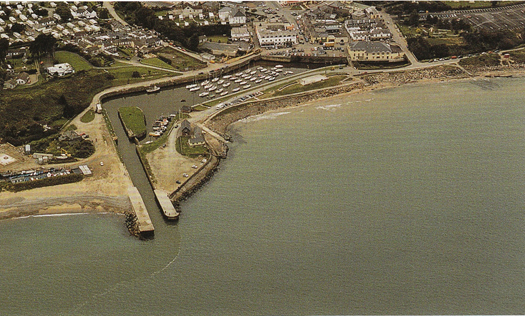
Courtown on Wexford's east coast is one of the harbours earmarked for urgent repair expenditure under this week's government scheme. Phot courtesy ICC/Kevin Dwyer
Many years ago, Paddy Barry set out to cruise round Ireland in his Galway Hooker St Patrick without using any anchorages recommended in the Sailing Directions by his fellow members of the ICC. It was just possible back then, and he overnighted at sixteen different places which were "unexplored". It would be virtually impossible to do that today, but even so it's entertaining to see if some favourite little places, some unknown quirky spots, have somehow slipped under the ICC radar.
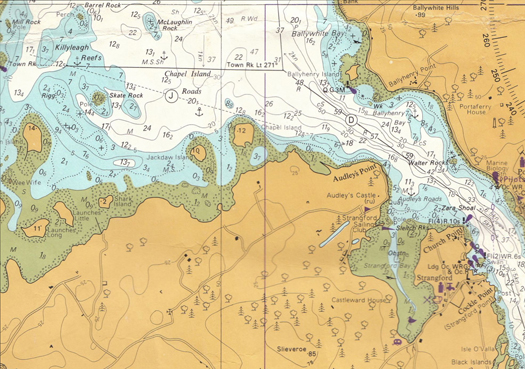
Has anyone overnighted there? The pool inside Chapel Island invites anchoring.
I can think of two, but have to admit that while I've seen them both, and seen boats in them, I've never taken a boat into either myself. One is a curious glaciated pool that is found behind Chapel Island in the southeast corner of Strangford Lough. At high water there's little enough shelter in the sound inside Chapel Island. But at low water, the classic Strangford Lough seabed emerges on either side, more than a metre high, while in the little pool you're lying in more than three metres. A couple of times I've seen a boat or two anchored in the area at high water while we've been hastening past entering or leaving the lough. But whether or not anyone has stayed on for the sweet entrapment at lower water I don't know, but would dearly like to hear from anyone who has.
The other secret place is one mile east of Rosslare ferry port. When the port was being almost completely redeveloped years ago, it seems they made this little harbour to accommodate all the local small boats which were being evicted from their long-established if often uncomfortable berths on the edges of the ferryport. It may well be that officially this harbour doesn't exist at all. As it is, there's a notice at it which states that the only people who are entitled to berth their boats there are persons normally resident in the electoral district of St Helen's, which is the area of Rosslare Ferryport. But for anyone cruising this tricky coast in a small boat, knowledge of the existence of this secret little harbour could even be a lifesaver when all other options have been closed off.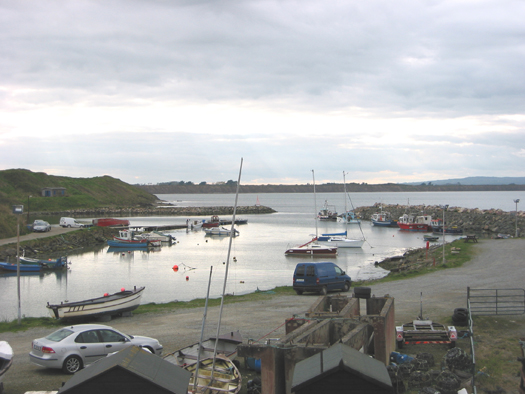
The secret little harbour one mile east of Rosslare doesn't claim to be a glamour spot, but it provides a very useful facility for local boat-owners. Photo: W M Nixon
It says everything about the completeness of the ICC books that these two little exceptions are the only unmentioned places I've been able to think of in the new East & North Coast book, and both are undoubtedly special cases. So once again Norman Kean and Geraldine Hennigan have created a masterpiece of it kind, a book which not only adds to safety when cruising our different regions, but greatly adds to the enjoyment of studying every aspect of our coastlines.
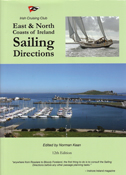
The latest and 12th Edition of the ICC's East & North Coast books continues a fine tradition of service to the cruising community which goes back to the first edition, a set of Roneo sheets produced in 1930. The new book is €37.50 (£29.95).
This blog was first published in March 2014.
#classicboat – W M Nixon's latest Irish sailing blog has drawing yachting historians into a facebook debate about historical yacht bow shapes. It started when Scottish reader Donan Raven from the Universtiy of Edinburgh sought further annotations on one of the early yacht racing images used by Nixon to illustrate his story on Dublin Bay Sailing Club and its 130th birthday celebrations this year. Read the comments so far by clicking on the facebook comments tab above.
As to the name of the clipper-bowed cutter in the RAYC 1888 photo, we haven't got it at the moment, but we'll set enquiries in train once St Patrick's Day has been put astern, says Nixon. Comment on facebook above. Read the full blog here.
Is Dublin Bay Sailing Club (DBSC) The Most Effective Sailing Organisation in the World?
#dbsc – Ireland's largest yacht racing organisation is Dublin Bay Sailing Club (DBSC), which administers the regular weekly programme for the entire Dun Laoghaire fleet. It has been such an accepted part of sailing's furniture for so long that it might be too easily taken for granted. W M Nixon salutes one of the great cornerstones of our world afloat.
Dublin Bay Sailing Club is 130 years old this year. Founded in 1884, it shares a birth year with the Gaelic Athletic Association. That's something I'd seldom heard mentioned by anyone, if at all, until the point was made in his foreword to the up-coming DBSC Yearbook 2014 by Commodore Pat Shannon. Yet it's a coincidence which is both incidental and fundamental. The two organisations in their very different ways are central to the areas of Irish life they serve so very well.
Perhaps the shared birth year goes unremarked simply because it's so bleeding obvious. So while we're on statements of fact from the IBO (the Institute of the Bleeding Obvious), might we be permitted another suggestion in that line? Sometimes, people from elsewhere wonder why major championships in GAA headquarters at Croke Park attract such enormous crowds, with upwards of 80,000 people roaring their hearts out. Naturally we'll respond to these outside enquiries with highfalutin lyricism about the sporting expression of Ireland in all her glory, the shared emotions, the rural soul of the nation. But on the other hand, at the end of the day (as they say in stadium sports), is it not something to do with the fact that, in our Gaelic sports, an Irish team always wins?
Be that as it may, there is equally something very Irish but also quintessentially Dublin – south Dublin, to be precise – about Dublin Bay SC. Its success owes much to the three great Ps – population, prosperity, and proximity. While most of the great cities of the world are coastal to some extent, few of them share Dublin's almost unique combination of circumstances which more or less force DBSC to thrive, even if today it is very different from the small boat sailing group which was set up in 1884.
Although the city is superbly situated on a graceful bay, the waters of Dublin Bay lend themselves much better to racing than cruising. You can have yourself a fine little cruise with many different natural mini ports of call within Sydney Harbour, and San Francisco is the same. As for the Solent or New York, or Washington and Baltimore, the choice of desirable sailing destinations within very easy reach is almost bewildering.
But in south Dublin, you have this intensely packed mostly affluent population crowded in along a fairly short bit of coastline, based around a large but entirely artificial harbour at Dun Laoghaire. There's immediate access to a rather open bay, but with no other proper harbours of significance within easy reach of an hour's sail other than Dublin Port itself. In such a location and with only two or three hours of spare time, what else can you do with a sailing boat but go racing?

The veteran Nich 31 Saki is one of the regular participants in DBSC Class 3 racing in Dublin Bay. So eclectic is the Dublin Bay cruiser fleet that Saki is by no means the most hefty boat regularly raced. Photo: David O'Brien
Thus one of the great strengths of DBSC, in its role as the overall racing body for the entire Dun Laoghaire fleet, is the provision of regular racing for large cruiser fleets which include some craft which, at any other port, would not be considered a racing proposition at all. But thanks to the sheer numbers of people wanting to get out and afloat and get a bit of fresh air on a Thursday night or Saturday afternoon or whenever, plus the impressive number of backroom volunteers who are prepared to record and analyse the results when they're provided with the elapsed times from real racing, an accurate picture of performance potential and a meaningful handicap system for just about anything that sails can evolve.
Obviously for this sort of intensely localised sport, a One Design class provides the most immediate return in quality of racing. And not surprisingly over the years, DBSC has been a stronghold and world leader of the One Design ideal. But it is a big enough and generous enough organisation to accept and accommodate a high level of individuality in boats and their owners, and the result at the height of the season is a social, sporting and seafaring phenomenon. People flock wearily homewards from work in the crowded city yet somehow - within minutes – they can be transformed into fully kitted energetic sailors out on the bay, shaping up for a start.
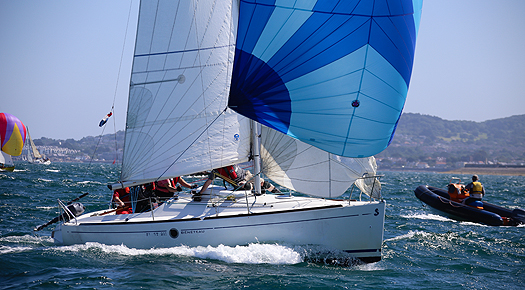
The 'new' Dublin Bay 21s, a contemporary Dublin Bay One design class. Photo: David O'Brien
But one way or another, Dun Laoghaire has a plethora of sailing clubs and organisations. How is it that the little club formed by Richard Fry and Dr W M A Wright and half a dozen friends in July1884 has become so pre-eminent? For, faced with a harbour dominated by the impressive clubhouses of the three established yacht clubs, DBSC's initial ambitions were very modest indeed, the club ethos being stated thus:
"In order to provide as much sport as possible with a minimum of expense, the races are to be strictly limited to open-sea boats with a light draught of water, such as can be easily rowed and beached if necessary".
Certainly as our lead photo from 1886 clearly shows, they fulfilled their original intentions to the letter. Yet within a dozen years, this unassuming little house-less club was promoting classes of substantial one design keelboats, and numbering among its active ordinary membership such social eminences as the Viceroy and other aristocrats who sailed.
At the time, the Royal Alfred Yacht Club, likewise a Dublin-based Corinthian organisation which functioned without a clubhouse, would have been expected to set the racing pace among the upper echelons of society. But the Alfred maybe set its sailing ambitions too high. Since 1870, it had been the lead club in formulating and developing the rules of yacht racing at national and international level. And it had always been a leading player in developing early offshore racing, with its Channel Matches an accepted part of the scene for many years.

A Royal Alfred YC Channel Match gets started in Dublin Bay in 1888. While the RAYC was promoting its ideals internationally and providing challenges for larger craft, Dublin Bay SC was quietly building its strength in their shared home waters with local boats.
Thus the Alfred's sights were set too high to cater for everyday Dublin Bay racing, week after week. Then too, over the years, its name became meaningless. While it meant a lot in 1870, subsequently there'd be those who'd think Royal was a brand of custard, and as for Alfred, wasn't he the dim son of Queen Victoria who'd been named after the guy who burnt the cakes?
But Dublin Bay Sailing Club......now there's a brand name to kill for. Whether it's prawns or people or boats or places, Dublin Bay has a zing. Clearcut, instantly recognisable, homely yet stylish, utterly reassuring, and only three very distinct syllables in just nine letters – Dublin Bay is a winner. In fact, you'd need to mess around big time to screw up the performance of an organisation called Dublin Bay Sailing Club. But happily there's never been any chance of that, as Dublin Bay SC dynamically reflects the basically very stable and successful society in which it is located.
An outsider looking at the history of Ireland in the first half of the 20th Century would wonder at this claim of "stable and successful". After all, were there not happenings like the Easter Rising, the War of Independence, and the Civil War crowded one upon the other in a turmoil to which the horror of the Great War of 1914-18 was the ghastly background? Maybe so, but as one of the members of the first Government of the Irish Free State put it, "we are the most conservative revolutionaries who ever lived". Several of these "conservative revolutionaries" lived in solid bourgeois comfort in the prosperous south Dublin community which saw Dun Laoghaire harbour as the centre of its nautical playground. And the private atmosphere of the yacht clubs had provided secure settings for negotiations over some of the key understandings and treaties which ended those troubles.
So south Dublin is used to getting on with it in a civilised way, and this attitude is transferred to its sport afloat. By the 1890s, with the emerging middle classes setting the developmental pace ashore and afloat, Dublin Bay SC was the right organisation in the right place at the right time in the Golden Age of yachting.
The actual Golden Age of sailing lasted only around a dozen years. Many factors contributed to the slowing of the pace, not least the growth of newer and more specialised shore sports. And we should never underestimate the rival attraction of the increasing popularity of the motor car, while aeroplanes also took some noted innovators off the sailing scene.
But for solid sailing enthusiasts, Dublin Bay SC was, and stayed, and still is, perhaps the most effective sailing organisation in the world. As it got into its stride in the 1890s, it blossomed with the promotion of the One Design Dublin Bay 25 in 1898, with the Viceroy Lord Dudley the owner of No 1, Fodhla, bought for him as a surprise birthday present by his wife.
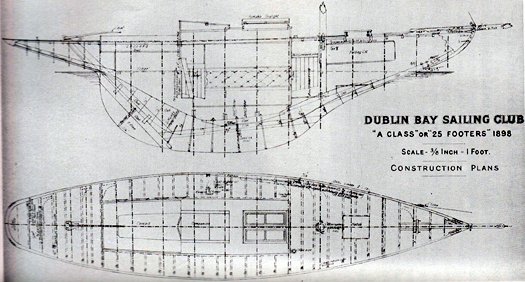
Quantum leap. The plans for the new Dublin Bay 25 in 1898. For a club which had started with small boats only fourteen years earlier, this was a remarkable development.
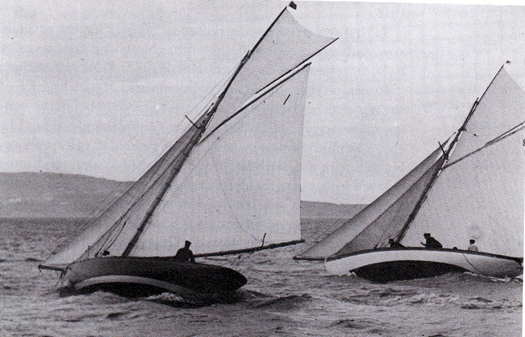
High society. DBSC member Lord Dudley racing his new Dublin Bay 25 Fodhla against R B MacDermott's sister-ship Acushla. Photo: Courtesy DBSC
Soon after, the Dublin Bay 21s hit the scene in 1902-03, and this underlined the sheer strength of the powerhouse which Dublin Bay sailing was becoming. Like it or not, it was metropolitan muscle, bringing good business to favoured boatyards near and far. There's a whole world in this photo of the Dublin Bay 21 Garavoge about to be launched in 1903 from James Kelly's little boatyard at Portrush on the North Coast.

The new Dublin Bay 21 Garavoge ready for launching in 1903 at Portrush with the DBSC burgee on stemhead, a great moment for owner W R Richardson, who stands proudly on left. Builder James Kelly, who four years later was to build the seven Dublin Bay 17s for DBSC members, is in the group on the right. Photo courtesy Robin Ruddock
Not all Dublin Bay one design and restricted classes were a continuing success. The boats built to the Half Rater rule., startlingly like early Flying Fifteens, proved too hairy and dangerous even for the hard-driving sailors of Ireland's east coast, and they were soon phased out. Then too the Colleens, ballasted centreboarders created by local builder James Doyle, capsized a couple of times too often to be cherished.
But the demise of the Colleens gave further indication of DBSC's steadily increasing power. In 1906 the Club was casting about for an able keelboat to replace the Colleens, and after much discussion they decided to use the design for the Howth 17s, which had been racing happily since 1898 as an able little keelboat one design in the waters of terra incognita way beyond Howth Head.
Herbert Boyd, Commodore of Howth SC from its inception in 1895 until his death in 1948, had designed the Howth 17s himself. But he was so chuffed that DBSC wanted to use his creation that he tidied it up, accepted that south of the Baily it would be known as the Dublin Bay 17, and even designed the option of a slightly larger cockpit, as it was acknowledged that Southsiders tended to be a little more portly than the lean and hungry Eastsiders of Howth.
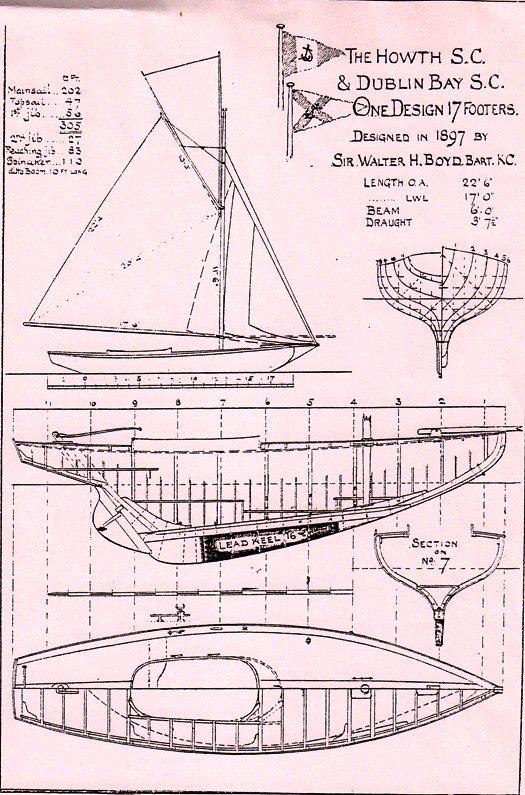
Plans of the "Dublin Bay 17" as tidied up by designer Herbert Boyd for the new Southside division of the class in 1907. As the Southsiders were better fed, they requested the option of a slightly larger cockpit.
It is now more than forty years since all the boats to the Seventeen foot design were re-grouped in Howth in 1972, yet you will still hear some absent-minded old buffers describing them as the "Dublin Bay 17s". All of which underlines the sheer power of the Dublin Bay brand. It's not that DBSC throws its weight about. On the contrary, it is a world leader in doing good work by stealth. But here it is, this enormous benign presence, and in the final analysis its word is law.
Currently, the classic case in point is the demise in Dun Laoghaire of the 17ft Mermaid Class. Designed by John Kearney in 1932 in response to requests from DBSC members, it became recognised as a class known as the Dublin Bay Mermaid in 1936. In its day, the Mermaid was a huge part of the fabric of Irish sailing, and its strength in Dublin Bay was phenomenal. But Dublin Bay moves on, however gently it may do so. Over the years it has allowed classes to wither and die as nature intended, while its members take up new boat challenges, often playing a key role in their development from the start.
So for the first time since 1936, there'll be no racing for Mermaids in Dublin Bay in 2014. Last year, they could theoretically muster half a dozen boats, but on the water the crucial figure of five boats racing to make the cut often wasn't happening. So now they're gone, to make way for new classes which rapidly achieve astonishing figures and take sailing in a fresh direction, such as the thriving First 211s.
However, part of the strength of DBSC is that the club accurately reflects what's happening afloat. Wooden boat racing may have suffered one blow with the end of Mermaid racing, but the energetic Water Wags seem to go from strength to strength. Originating in 1887, the class set a precedent in 1903 by retaining its class organisation, yet changing its boat type completely from a little double-ender to a much more substantial transom-sterned sailing dinghy, modern in its time, which today musters healthy fleet of more than two dozen.
But in a quietly but relentlessly forward-moving society like south Dublin, some boats inevitably fall by the wayside, and for wooden racing boats in Dun Laoghaire, size seems to be crucial for survival. The Water Wags may thrive, but the Mermaids – three feet longer – require that little bit of extra work, that final additional straw of shoreside man-handling which breaks the camel's back.
As for the Dublin Bay 21s and 25s and 24s, they're long gone. Whether the old 21s, mouldering in a Wicklow farmyard, ever sail again is a moot point. But it's still possible that their newer bigger sisters, the Dublin Bay 24s, will sail again as pampered toys known as Royal Alfred 38s in the South of France.
There's a considerable irony in this, as the pioneering 24s – boats conceived as slightly beefier seagoing Six Metres - were first suggested at a committee meeting of the Royal Alfred YC in 1934. It was a good idea, but the RAYC could carry it no further, so by the late 1930s they'd become the Dublin Bay 24s, and six were being built. World War II from 1939 to 1945 then interrupted their progress, but in 1947 the new Dublin Bay 24s made their debut, and they re-confirmed Dublin Bay SC in its pre-eminent role. They were brilliant boats for racing in the bay and at East Coast regattas, they could cut the mustard in RORC Racing (one of them won the RORC's Morecambe Bay race overall when it went through a gale in 1964), and they were superb fast cruisers, picking up several major ICC awards.
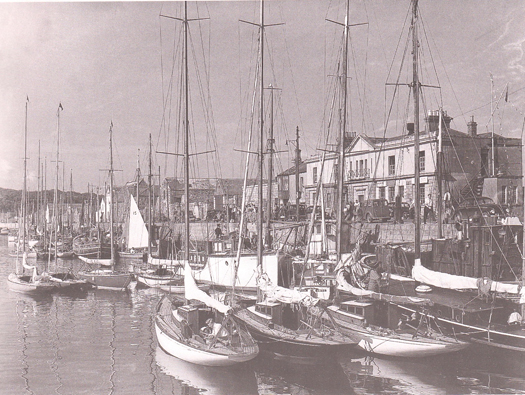
Three of the new Dublin Bay 24s make an impressive sight visiting Howth Regatta in 1953. Offering high quality racing in the bay, with wins offshore in RORC events, and proven cruising ability, in their day they were one of the most successful DBSC classes.
Yet the fact that the 24s are long gone from Dublin Bay is just the way it is. Life moves on, situations change, and DBSC - in successfully reflecting the sailing environment in which it functions - is in its understated way a genuine power in sailing, a thoroughly good thing.
It achieves this through a code of volunteerism which would be emulated by many other organisations, if only they knew the secret of the secret ingredient. It's difficult to pin it down, but the underlying DBSC ethos is found in all the memberships of the Dun Laoghaire clubs. But not necessarily in all the members. Serving Dublin Bay SC is a high calling, a vocation given only to a special few. And the people who run it are a band of brothers and sisters, who also happen to be the best of friends. The Code of the Bay is something that becomes elusive as you try to analyse it, so let's just be happy to enjoy it, savouring the wonderful sport provided by this extraordinary organisation for thousands of sailors in boats of every type.
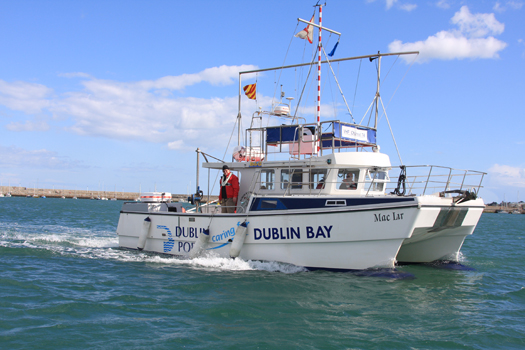
Mac Lir, one of two fast catamaran style Committee Vessels operated by DBSC on an all year round basis. Photo: David O'Brien
Sailing Club of the Year Awards, A History of the Inter–Club Contest
#cluboftheyear – The Mitsubishi Motors "Sailing Club of the Year" for 2014 will be announced tonight. W M Nixon looks back on a unique inter-club contest with which he has been involved since its inception 35 years ago, and reflects on a challenge to the Royal Cork's position of historic significance as the oldest yacht club in the world.
Is the Royal Cork Yacht Club, descended directly from the Water Club of the Harbour of Cork with its establishment in 1720, really and truly the oldest yacht club in the world? The nautical blogosphere and its comments departments have been busy of late, as folk became exercised about the "new" discovery that the Squadron of the Neva, a potential rival claimant in Imperial Russia, was founded two years earlier in 1718.
We've been here before, thanks to the Mitsubishi Motors "Sailing Club of the Year". This informal contest, completely unique when it first appeared in 1979, has long since become an accepted part of Irish sailing. It has served several useful purposes in that it has more clearly analysed what it is that makes the best of Ireland's remarkably successful yacht and sailing clubs tick, it has given us a template for club development and fulfilment, and it has provided a complete record of an important part of Irish sailing history simply because we now have a list of the many winners going back 35 years.
It started in the weirdest way. Sean O'Shea, a good old-fashioned Dublin PR man, was in his car in a traffic jam outside an antique shop in the city centre in 1978, and while stopped he ran his eye over the items on display, which included a ship's wheel. It was quite some traffic jam, for by the time he was moving along again, his busy brain was developing the notion of using the old wheel as a trophy in sailing. When he'd finally reached his destination, he'd decided that it should be some sort of trophy for sailing which would have the unique feature of somehow being awarded to people who personally might not have actually won some sailing race or other.
In those distant days, all of Ireland's national newspapers (all three of them) carried weekly columns on sailing, acres of newsprint with regular photo usage. I wrote the one for the Irish Independent, so he cast a fly over me as to how this "awarding everyone" concept might best be done, for he could see PR opportunities for one of his client companies in it. We kicked some ideas around (in a classic Dublin pub of course, Sean was a connoisseur of Guinness) and somehow the notion – utterly crazy at the time - emerged of a Club of the Year contest.
Back in 1979, if there was such a contest anywhere else in the world, we didn't know of it. So I went home and bashed out the defining characteristics of a successful sailing club on the little Olivetti typewriter (I produced so much verbiage in those days that a new Olivetti every 18 months was an essential), and soon discovered that there was a lot more to the successful clubs than staging popular and stylish events and having members who won major championships.

The 1980 winner was Malahide YC, and the presentation was a two part ceremony, with the ship's wheel being presented aboard a ship in Dublin port, while the celebration took place in MYC's new clubhouse. Photo shows Frank Cormican (left) of original sponsors Coal Distributors, and MYC Commodore Peter Killen aboard the ship. Peter Killen became the Commodore of the Irish Cruising Club on February 14th 2014.
There was the requirement of having good and pro-active relations within the community of which they were part, which was an odd enough idea in 1979, when most clubs seemed aloof, or at the very least self-absorbed. There was of course the obvious requirement of encouraging newcomers to the sport, while having the good sense to know who would be worthwhile sailors and members, and who would not. There was the cultivation of good use of the media, limited and all as it was in those days. There was the need to foster junior development and sail training programmes for all ages. And most important of all, there was the need to have catered for your members' needs, to have brought them along with you in enthusiastic support of new projects, and to have maintained and developed that spirit of volunteerism within the membership which is the essence of the good Irish sailing club.
While "community" may be an over-used word these days, back in 1979 the idea of applying it to a yacht club was still a novel notion, but we decided we'd try to see how the concept of community manifested itself within the clubs which were emerging at the front line of this new informal contest. In the form in which the Club of the Year competition was to emerge after six years of growth, the system which proved to work best was when we simply included all the 120 clubs in Ireland in it – there was no need for any formal entry, as we reckoned the club staff of those days, most of them voluntary, had quite enough to be doing without having to fill out yet another lot of forms.
A small panel of adjudicators was established, and they only emerged (and even then only if they wished - some preferred to remain anonymous) at the award ceremony. The idea was to cover the country, but under the radar. The adjudicators were active in sailing, and between us we were directly engaged with virtually all of the clubs in the country in any one year. But this adjudication was not done on official visits. On the contrary, the idea that clubs would be aware that they were being assessed at any particular time was anathema to the central notion that it was the club's primary duty to serve their own membership, and you could do this best by managing to have a visit more or less unnoticed, as part of a crowd of participants in some sailing event, or as the attendance at a social gathering, or - sometimes best of all - simply under the guise of a visitor from another club hoping to enjoy the fraternal hospitality of the club being scrutinised. This was how it all gradually developed, but it took time for the requirements for a successful inter-club competition to emerge.
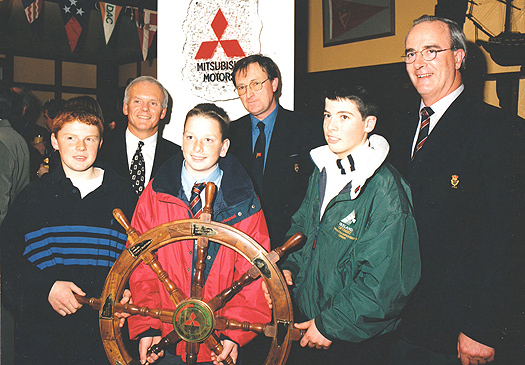
The ground-breaking presentation to the Royal Cork YC for 1992's great season. In the background are Eugene O'Reilly (Mitsubishi Motors) outgoing Admiral Kevin Lane, and incoming Admiral Anthony O'Leary. Twenty-one years down the line, how has it been going for the junior sailors in the foreground? Photo: Bob Bateman
Back in the late 1970s, Irish sailing was a much less vigorous creature than it subsequently became, and the affluence of the country was at a very low level. For the first few years, the sponsor, drawn from Sean O'Shea's decidedly eclectic portfolio, was a conglomerate in the coal importing business. In retrospect, that feels only marginally better than a tobacco company. But they wanted to give themselves a fresher image, we had the vehicle, and the show was on the road.
The first winners in 1979 were Wicklow Sailing Club, who had broadened their scope that year with a family cruising rally initiative. When you consider that in 1980 they inaugurated the Round Ireland Race, it gives you some notion of how quiet the sailing innovation scene was in the 1970s. Back then, the hottest show on the sea throughout the decade was the annual programme of the Irish Sea Offshore Racing Association, which at its peak attracted 107 boats to its annual season-long championship.
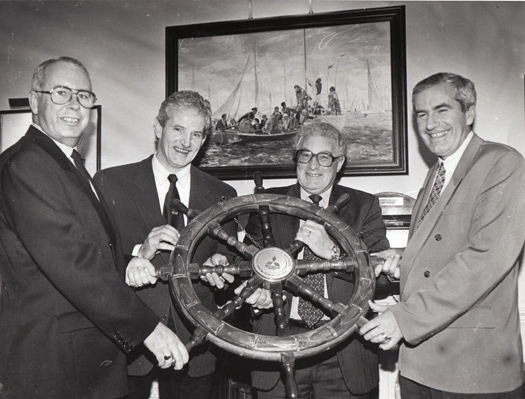
1993 saw the first dual award, to the National YC of Dun Laoghaire and the St Brendan Sailing Club of Dingle for the successful introduction of the Dun Laoghaire to Dingle Race. At the presentation were (left to right) Brian Barry (NYC Commodore), John O'Connor (Dingle commodore), Frank Keane, Chairman of Mitsubishi Motors, and Barry Rose. As Commodore of ICRA, Barry Rose was himself a winner in 2011 to honour Ireland's 2010 Commodore's Cup victory.
The first awards ceremony was a very low key affair at a small reception in the Gresham Hotel. But by the following year, there came an increased awareness that merely handing out the ship's wheel trophy at a Dublin city centre venue to facilitate the press simply wasn't good enough. Every successful club is at the heart of its own universe, however small, so the only proper way to honour the winning club is with an award ceremony in its premises, which has the additional benefit of making a useful injection into bar and catering turnover.
So in 1980, there was a compromise. The winners were Malahide YC for managing to build their very attractive new clubhouse despite the Irish economy being in its default mode of contraction. But the coal company felt there should be some gesture towards who they were. So one half of the ceremony took place on board a huge bulk carrier unloading coal in Dublin docks, and then everyone – led by those Malahide stalwarts Sam Dix and Jock Smith – went haring up the road to Malahide to celebrate it all in the lovely new clubhouse with very considerable exuberance.
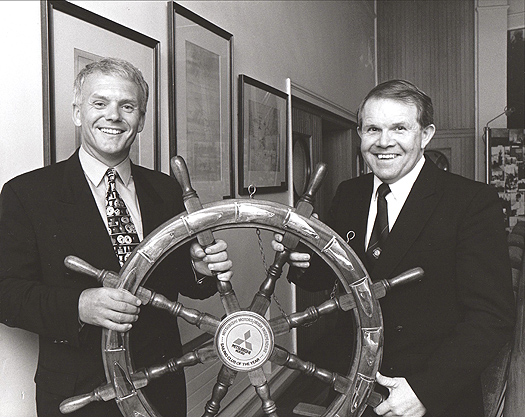
1995 was Howth YC's Centenary, which was brilliantly celebrated to make them Club of the Year. With the ship's wheel are Eugene O'Reilly of Mitsubishi Motors, and HYC Commodore David Lovegrove
For the first six years, the competition was restricted to clubs on the Leinster east coast, as that was the area covered (in every sense) by the coal company. But in the mid-1980s Frank Keane, that extraordinary bundle of energy and innovation in the motor business, decided that he needed to balance his extremely successful BMW distributorship with a Japanese model aimed at a different segment of the market. So he took on Mitsubishi Motors just as they were launching vehicles which might have been made for Irish roads such as the Pajero. As he was another of Sean O'Shea's clients, in very quick order the Club of the Year award acquired an excellent and enthusiastic sponsor, and it went national.
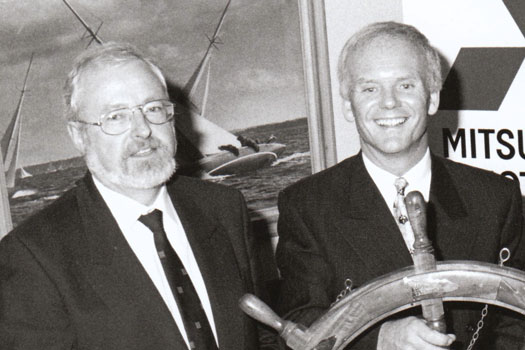
To honour a remarkably successful season achieved in 1997, Kinsale YC were Club of the Year for 1998. Commodore Pat Pyne accepts the trophy from Eugene O'Reilly.
Becoming an all-Ireland thing with 120 clubs under consideration was a quantum leap, but when you find yourself being encouraged by the top people in the motor business, you're in a different league. They're as tough as old boots, yet utterly human and thoughtful underneath it all. It's difficult to tell sometimes if it's delight in business or shared joy in good cars which motivates them, but it was an eye-opener for the rest of us as the Club of the Year trophy went to all parts of Ireland.
In every corner of the country, however remote, Frank Keane would have as a guest some old customer who'd bought one of the very first BMWs from him many years earlier, and had bought several ever since, some of them on an annual basis not because the cars wore out, but because he was such a pleasure to do business with.
But it was a while before we settled into this successful pattern, and for the first year with Mitsubishi Motors, the ceremony was in the Dublin area in any case, with Howth YC being the 1986 winners, neatly timed as the awards ceremony was one of the first events in their startling new clubhouse in April 1987.

Kinsale sailors with their trophy in April 1998. Front row includes KYC Commodore Pat Pyne (left), Eugene O'Reilly (centre) and John Twomey, now President of International Federation for Disabled Sailing (right), while on the right in the back row are international yacht designer Ron Holland, and Figaro skipper Damian Foxall, who sailed under the Kinsale burgee.
But through 1987, one club was to be head and shoulders above all others. The Royal Cork, oldest yacht club in the world dating from 1720, was on one of its frequent sprints, achieving in all areas. Yet around that time, yachting historian Hal Sisk was voicing his reservations about Royal Cork being the world's most senior club, pointing out that it was absolutely definite that an organisation called the Squadron of the Neva had been established in Russia by Czar Peter the Great in St Petersburg in 1718 with the express purpose of encouraging the sons of the aristocracy to take up recreational boating.
It was an interesting point, and it had to be addressed. So when at year's end the Royal Cork were announced as the Club of the Year (and they've now won it five times in all), somehow a crazy idea arose. We wouldn't go all the way down to Crosshaven to present them with the trophy. At the best of times, it was a tricky proposition for Mitsubishi Motors and the Irish Independent alike, as it would have taken us into the heart of Ford territory and Cork Examiner land. But instead, we'd see if we couldn't arrange to have the presentation in the Russian Embassy in order to acknowledge our awareness of the claims of the Squadron of the Neva, while highlighting the magnificent achievements in 1987 by the Royal Cork YC.
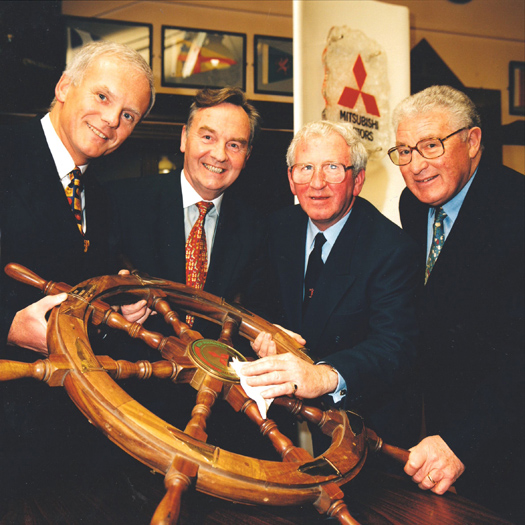
1998 saw the Tall Ships visit Dublin in large numbers, and volunteers from all over Ireland converged on the port to assist in the massive logistics support operation afloat in the harbour. Poolbeg Yacht & Boat Club in Ringsend was the focal point for his superb exercise in co-operation, and it was celebrated by PY&BC becoming Club of the Year for 1999. At the award ceremony are (left to right) Eugene O'Reilly (MD Mitsubishi Motors), Minister for the Marine Dr Michael Woods TD, James O'Donnell (Commodore, PY & BC) and Frank Keane (Chairman, Mitsubishi Motors).
This was to be done in the early Spring of 1988. It was a tricky proposition. Although Perestroika and Glasnost were becoming evident, the Berlin Wall wasn't to fall until 1989. The Soviet Union may have been creaking and rattling more than somewhat, but the fine house in Dublin's elite ambassadorial belt was still very much the embassy of the USSR – the Union of Soviet Socialist Republics. Calling it the Russian Embassy was getting ahead of the game. This was the eastern bloc's headquarters in Dublin, with the Cold War still very much with us, and no mistake.
Yet they agreed to host the party. So now we'd equally tricky negotiations. Would the Royal Cork YC agree to come to Dublin on such a bizarre mission? God bless them, they came in force. We had the makings of the most unusual party ever staged in Irish sailing.
Our host was the Soviet ambassador himself. If in the 1980s you'd asked for Central Casting to send you an actor to personify the popular conception of a Soviet diplomat, they'd have sent you Gennady Uranov. Though he was qualified as an engineer, in the continuous turmoil and unexpected outcomes of Russian and Soviet history, somehow he'd ended up in the diplomatic service and done comfortably well, as the embassy in Ireland was a very agreeable posting. Fairly heavily built but in trim shape, with well-tamed strong grey hair, the ambassador had presence, with charm and an occasional sense of humour. Nevertheless he was very much on his guard, as this was an unusual event, indeed an unprecedented one, and with turmoil back home the embassy people weren't a hundred per cent certain, for all that they'd got approval from headquarters as to how their actions would be interpreted back in Moscow, let alone who would be doing the interpreting.
Meanwhile, we'd our own little drama to play out. As part of the evening's programme, Hal Sisk outlined in detail the Squadron of the Neva's claims to seniority. It has to be admitted that the faces of the Royal Cork group were not those of happy budgies. Nevertheless they manned up and accepted the ship's wheel trophy with good grace, pleasantries were exchanged between all parties with the ambassador being a sort of amiable Russian bear in the midst of it all, and then I'd to deliver the adjudicators' reasons for the Royal Cork being the Club of the Year.
It was soon done, but the moment was too good to miss. As we'd everyone relevant there, the opportunity to blow the Squadron of the Neva's claims of seniority clear out of the water was taken with enthusiasm. The point was made that the Water Club of the Harbour of Cork established precedents for what a sailing club should be, right from the very start. The first Admiral may have been Lord Inchiquin of Rostellan Castle on Cork Harbour, but his fellow members, while they may have been rich – very rich by Irish standards – were "commoners", joined together in a self-starting society of mutual support and agreement in order to express a shared interest and pleasure in sailing, and adhering to a collection of self-generated club rules which were so effective that many of them are still relevant today, with the rules of Water Club having a contemporary feel despite the fact that they were codified by equals back in the middle of the 17th Century.
The Squadron of the Neva, on the contrary, wasn't a club at all. It was a small unit of the Imperial Russian Navy, imposed by the diktat of an omnipotent Czar who wanted to make his governing classes more sea-minded. There is simply no comparison with the Water Club, which has provided the template for democratic sailing clubs ever since. But the rigid structure of the Russian organisation was something else altogether, and is only of relevance in how to organise a navy, or more accurately – judging by the outcome of the Russian-Japanese War of 1904 – how not to organise a navy.
That historical point having been clarified to the approval of the Royal Cork, the Mitsubishi Motors "Sailing Club of the Year" took off at national level, and when the Royal Cork won it again in 1992, there was no hesitation in venturing into the Indian territory of Fordland and Cork Examiner country for the award ceremony, with the Crosshaven clubhouse's flagpole dressed overall in April 1993 for a monumental party.
Anthony O'Leary had just been elected Admiral, but his predecessor in 1991 and 1992 had been Kevin Lane, whose acceptance speech was distinctly thought-provoking for those of us who might have been treating the Club of the Year business in a light-hearted way. Kevin Lane spoke briefly but forcefully. He said quite clearly that when he became Admiral in advance of the 1991 season, he called his top sub-committee chairmen together, and told them that that the underlying thread of his two years in office would be to fulfil a programme afloat and ashore so through and enthusiastic that there would be no doubt by the Autumn of 1992 that Royal Cork was going to be the new Club of the Year.
The adjudication panel were astonished and silenced for a little while, for we'd known nothing of the Admiral's mission statement in 1991. This was awesome stuff. But with the Royal Cork setting the standard in 1992, and having set the standards back in 1720, the ship's wheel trophy was now part of Irish sailing heritage, and so it has remained ever since, with tonight's announcement being followed in due course by a handover ceremony at the winning club as the new season gets under way.
But as we get this glimpse of the future, spare a thought for those who were there in the Soviet Embassy back in 1988. One outcome was that an unlikely friendship was struck up between Eugene O'Reilly, Financial Controller and later MD of Mitsubishi Motors Ireland, and Ambassador Gennady Uranov. It became more than an exchange of pleasantries and letters. Eugene and his family went to stay with Gennady and his family in Russia, and holidayed with them. The Irishman was disconcerted to find that, in addition to his diplomatic role, his host was a Colonel in the Russian secret service, the KGB. Not to worry, said Gennady, everyone who's anyone in Russia is a Colonel in the KGB – it's like a sort of combination of the Freemasons and the Knights of Columbanus.
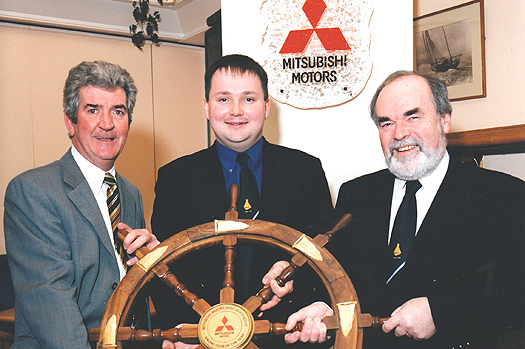
With the new Millennium, the competition was expanded to include Class Associations, and subsequent winners have included the Shannon One Design Association. In 2001, the winner was Ireland's (and the world's) oldest One Design keelboat class, the Howth 17s, established 1898. The trophy was presented to incoming Class Captain Marcus Lynch (centre) by Paddy Murphy (left), Marketing Manager, Mitsubishi Motors, with Frank Cruise, outgoing Captain Howth 17 Class Association.
Alas, whichever branch of this secretive organisation he was in, the former ambassador to Ireland proved to be on the wrong side of the rapidly-changing new developments in Russia. He was dropped from the diplomatic service, and sent to the salt mines. That's not quite as dreadful as it sounds. With his qualifications, he became a senior engineer in Russia's vast salt mines. Many would have regarded it as a plum job. But for someone who'd fitted comfortably into life on the Dublin diplomatic circuit and had quietly relished hosting the occasional unusual party for sailing weirdos who used his hospitality to dispute obscure points of history, it must have been grim.
And who knows, but perhaps something which came out of Gennady Uranov's introduction to the Irish sailing community may have hastened his downfall. For he was so taken with it all that he arranged for his two sons to be enlisted in the Royal St George Yacht Club junior training programme in Dun Laoghaire. Quite what the founders of the George – Anglican Ascendancy establishment figures to a man – would have made of their successors accommodating the children of the senior agent in Ireland of Godless atheistic communism heaven only knows, yet it happened.
So perhaps his downfall came about because someone in the Kremlin spotted a celebrated headline which was splashed across an Irish tabloid when an ace reporter discovered that the Russian ambassador's sons were going yachting.
RED SONS IN THE SAIL SET, it said. It may have delighted Dublin journalists, not least in that the song Red Sails in the Sunset was written by Irishman Jimmy Kennedy. But it can't have pleased the heirs of old Joe Stalin.
The Irish Heart is Still in Wooden Boats
#woodenboat – Wood used to be the material of choice for boat-building. But it has long since been superseded by glassfibre and other variations of plastic, while aluminium – for more than two centuries the "metal of the future" - is now widely accepted for small boats which get rough usage but little maintenance. Yet wood still talks to us. It's part of what we are. W M Nixon takes a look at some current Irish wooden boat-building projects.
It's one of the most natural things in the world to feel an affinity for wood, and enjoy working with it. It's right there in our DNA. Back in the mists of time, when early man was emerging from a primitive wandering existence, the ability to make fires and tools and weapons with wood, and even better the ability to create a shelter from wood when no cave was available, could make all the difference between life and death.
Those early humans who saw wood as something beyond the means merely to make a fire had a superior inbuilt survival mechanism. This in time evolved as an instinctive fondness for wood, a positive emotional response to working with it. Even nowadays, when we live in a world dominated by synthesised materials and mass-produced objects, simply going into a traditional woodworking shop or boat-building shed triggers a favourable atavistic response. We feel comfortable. We love to run our hands along the timber, and savour its aroma. Our heads may tell us that plastic and metal work better for many regularly-used objects, but our hearts are still in love with wood.
Any boat-building project in Ireland will always attract a level of interest way beyond the size of the boats involved if the boat is being built in timber. Don't get me wrong, though. Glassfibre is undoubtedly a wonderful boat-building material which – uniquely – is created as the boat is being built. And I've been using a lot of it in the epoxy version in my own boat's re-configuration project. But while you appreciate its excellence intellectually, there are very few people who respond with favourable emotions to the sticky business of working with it, which is something best done as clinically and cleanly and quickly as possible.
Pure working with wood, on the other hand, is just so comfortable, so reassuring. You can happily linger over it. You never find yourself wondering if this is what nature intends you should be doing. On the contrary, in working with wood, we fulfil a natural imperative. And little wooden boats of traditional shape are a special joy.
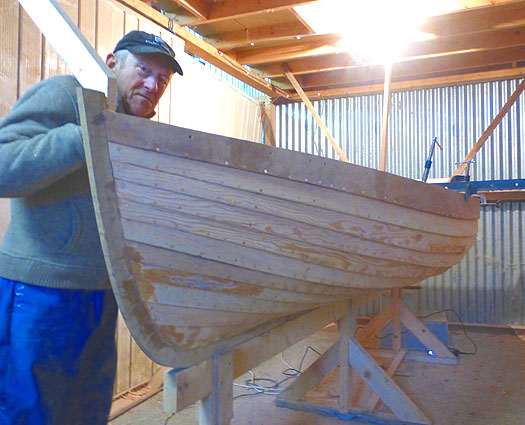
Larry Archer, best known as one of Ireland's leading glassfibre boat-building pioneers, has particularly enjoyed returning to his earlier skills as a classic wooden boatbuilder in re-creating the Asgard dinghy Photo: W M Nixon
Not least of their special joys is that, as we emerge from recession, building a small wooden boat has all the pleasures of traditional boat-building, yet with manageable expense. Thus a classic ten foot clinker dinghy perfectly fits the bill in these straitened times. And as she has the impeccable pedigree of being to a design by the great Colin Archer of Norway, the excellent value for money is beyond dispute as this little boat nears completion in a hidden shed in the depths of Fingal.
But the actual working with wood can be every bit as important as the classic or modern nature of the design, and equally intriguing is the City One project in Limerick. There, people who otherwise mightn't get a chance to build a boat, let alone sail one, are much involved with building modern dinghies to a design by Theo Rye. This is being done in a project under the Ilen umbrella, the Ilen being the Conor O'Brien ketch of 1927 which the Ilen Trust is restoring with trainee shipwrights.
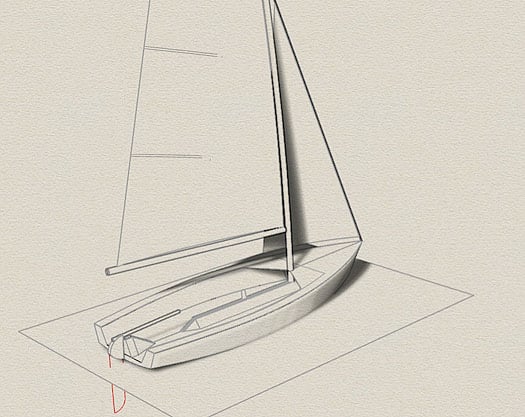
The new City One performance dinghy for Limerick has been designed by Theo Rye.
Over on the East Coast, a boat with distinctive neighbourhood sailing connections can provide a very tangible focal point where a sense of place is sometimes difficult to discern in the region's increasing urbanisation. In Bray, they're reviving that seaside town's local sailing traditions by building new boats to the 12ft Droleen design, which was designed specifically for Bray small boat enthusiasts by local sailing man W Ogilvy way back in 1897.
Ogilvy's original designs had faded, so quite some time ago the Bray people got the late O'Brien Kennedy to re-create them, and the result is such an attractive and able twelve footer that they've not only built the first new one to acclamation in Bray, but across in Spiddal on the Galway coast that renowned boat-builder Jim Horgan of Galway Boatbuilding School – who has created an astonishing total of 200 wooden boats in his time – has built another Droleen for general use in Connemara. It has proven "such a neat little boat", as he so aptly puts it, that another is likely in the near future.

"A neat little boat". The community-built Droleen nearing completion in Bray. The classic design has also been successfully used for a small workboat in Connemara
The Asgard dinghy is a replica of the little boat which Colin Archer designed and built in 1905 for Erskine and Molly Childers to be the tender for the newly-married couple's wedding present from her father, the 51ft ketch Asgard which became part of Irish history with the Howth gun-running for the Volunteers in July 1914.
Asgard is now conserved, and is the centrepiece of a simple yet very effective display in the Collins Barracks museum in Dublin. But as John Kearon and his team neared the completion of their excellent conservation project, the economic recession struck home, and it became clear that Government funds would not run to fitting any sort of rig to the boat.
However, a new squad of Volunteers emerged from a wide variety of sailing backgrounds in the hope of putting some kind of rig in place in order to give a better idea of what Asgard looked like in her prime, using spars which included the original mainboom. There was no stopping this team, which is not surprising when you consider it included global circumnavigator and former dinghy champion Pat Murphy, Arctic explorer and voyager Paddy Barry, long distance solo sailor Mike Alexander, multiple inshore and offshore sailing champion Neville Maguire, and intrepid sailor/boatbuilder Wally McGuirk and his son Rory.
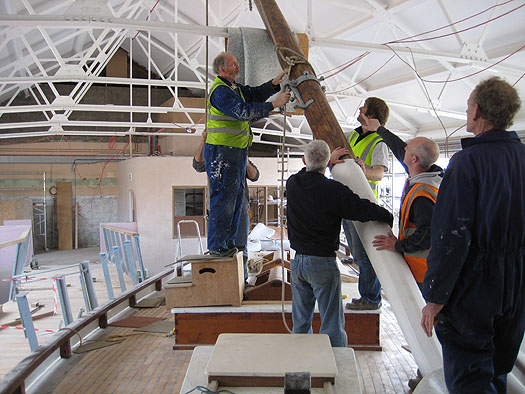
The "new Asgard volunteers" stepping the mast in Collins Barracks. Photo: Neville Maguire

Even though the rig height is very limited by a shortage of headroom, Asgard as she is now displayed looks much better for having something which shows how she appeared when fully rigged. Photo: W M Nixon
Thanks to their work, despite the limited headroom in the Asgard Museum we now have a much better idea of how this wonderful vessel looked in her prime. But as she is so permanently installed as a national monument in Collins Barracks, there's no way she's going to be readily moved for anything, not even the Centenary of the Howth Gun-Running on July 26th this year. So the new Volunteers began to think of building a replica of the Asgard dinghy, whose basic plans were discovered by John Kearon in the Colin Archer archives in the Norwegian Maritime Museum in Oslo.

Sketch plan of the proposed 10ft dinghy for Asgard as drawn by Colin Archer in 1905. Courtesy John Kearon
Though they'd made a fine job of Asgard's shortened display rig, they didn't see themselves as qualified boatbuilders for the detailed construction of a classic little clinker dinghy. But fortunately Fingal boatbuilder Larry Archer – and no, he's not Colin Archer's great-grandson as some have surmised – has the necessary traditional skills in abundance, even if he is noted as one of the pioneers of glassfibre boat-building in Ireland.
In fact, Larry is the classic illustration of my point that much as we acknowledge the sheer good sense of quality boat-building in fibreglass, there is still nothing so profoundly satisfying as traditional boat-building in wood. So he agreed to build a replica of the Asgard dinghy in a manageable budget, and as the boat nears completion, Pat Murphy has raised the money from Asgard well-wishers, and businesses in the Howth area.
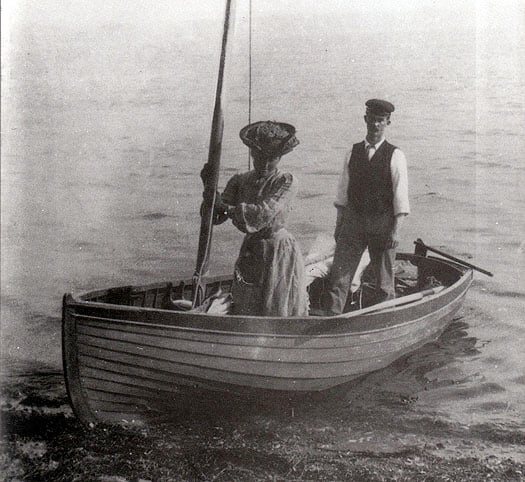
Molly and Erskine Childers with Asgard's dinghy

Asgard as seen from the dinghy during a cruise around 1910 Photo courtesy TCD.
But aside from the historical significance, like the Asgard herself this little boat has a significance all of her own. Nowadays, with the ready availability of inflatables and small RIBS to act as safe cruising yacht tenders which can be stowed on deck, we've forgotten that in times past, cruising people had to make do with dangerously small rigid boats for tenders if they wished to stow them on deck. And if they wanted a high level of safety in their tender, they had to be prepared to tow it.
In fact, in the 1930s, the Clyde Cruising Club had a rule that yachts racing in their annual Crinan to Tobermory Race, which marked the start of the traditional Glasgow Fair fortnight's holiday in July, were obliged to tow their dinghies. Much effort therefore went into designing dinghies which were safe yet sweet of line, and we've a classic photo of the great John B Kearney's 38ft yawl Mavis from Dublin Bay coming in to Tobermory in 1938 after winning the race from Crinan with the little dinghy under tow the whole way.
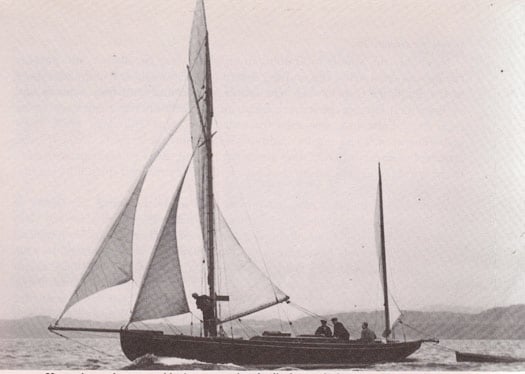
John Kearney's Mavis coming into Tobermory Bay in 1938 after winning the CCC race from Crinan, and towing the dinghy as required by club rules.
There's a direct link to the team connected with today's building of the Asgard dinghy, as the next photo we have is of Neville Maguire in his schoolboy short trousers rowing the Mavis dinghy in to the pier at Schull after placing second in the Irish Cruising Club's 1945 race from Crosshaven round the Fastnet.
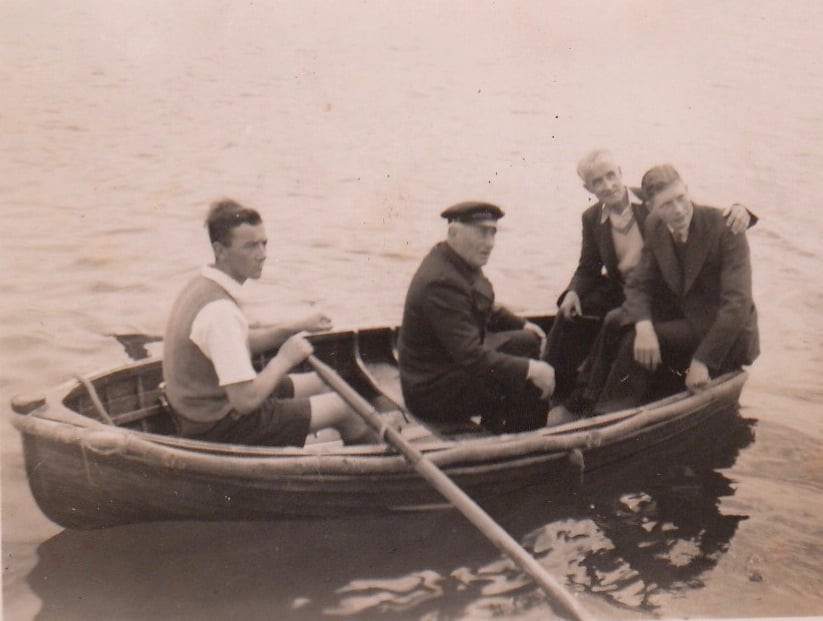
Neville Maguire in 1945, rowing the Mavis dinghy in Schull, with Skipper Kearney amidships.
To work properly, these little dinghies had to be miniature masterpieces, and in re-creating the 10ft Asgard dinghy, Larry Archer had the devil's own job in getting the planking to take on the required twist in under the transom in order to match Colin Archers tightly turned lines, which enabled the little boat to carry weight, yet tow easily and lightly when unladen. In fact, he reckons that the original must have been built with a supple newly-felled tree, whereas he was working with timber left over from the Asgard conservation, and there was one split plank before they got it right for a very fine job.
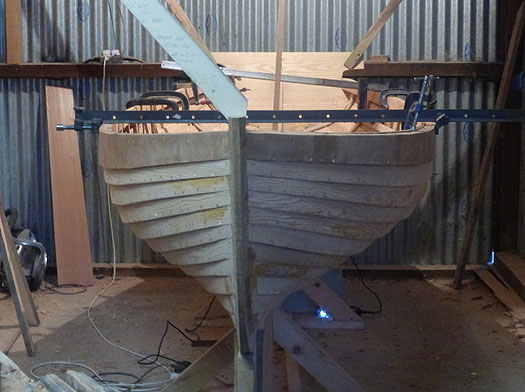
The Colin Archer-designed Asgard dinghy has a particularly elegant shape Photo: W M Nixon

As the Asgard dinghy nears completion, the tight turn to the planking under the transom is clearly seen. Photo: Pat Murphy
The boat wasn't designed with a centreplate, but she carried a little lugsail, and a rudder was fitted. Anyone who has ever sailed a clinker dinghy with the plate up will know that, from a standing start, she'll simply sail sideways. But if you get forward way built up, it's surprising how well the bit of lateral resistance provided by the rudder and the small amount of immersed hull enables you to make better to windward than just a beam reach, allowing all sorts of attractive little sailing options when the mothership is at rest in a pleasant anchorage. And if you do need to make real progress dead into the wind, she rows a treat.
Windward work will be no problem at all with the new City One dinghies from Limerick. Looking at the workmanlike lines drawn by Theo Rye, who got to know Gary MacMahon of the Ilen Trust when they were working together in the Peggy Bawn publishing team producing the massive history of the work of designer G L Watson, the analogy that springs to mind regarding windward work by the City One is "Rat up a Drainpipe".
Construction under way in Limerick on the first City One. Photo: Gary MacMahon
The emerging hull shape, designed for speed. Photo: Gary MacMahon. Photo: Gary MacMahon
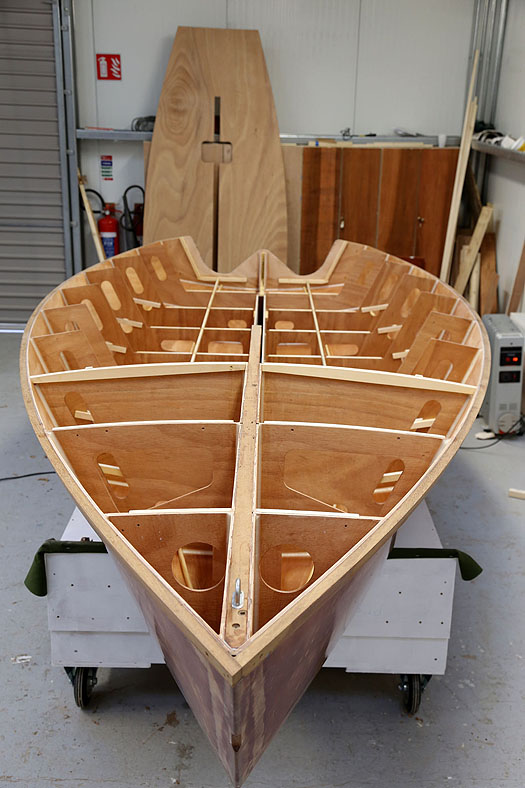
The City One is an impressive example of timber engineering. Photo Gary MacMahon
These will be potent performers, well able to hold up their heads in any race fleet, and it has been a flash of inspiration by the Ilen team to go for this type of boat rather than some sort of conservative option which would provide a maximum number of berths afloat, but a rather dull sailing experience.
By working in wood with the epoxy technique, they're getting the best of both worlds. But the Ilen organisation spreads its tentacles widely, and another of their wooden boat-building project is the re-creation of the classic Shannon and Limerick gandelows, which evolved a flat-bottomed hull shape to be able slither across those acres of mud which are inevitable at low water in the estuary, as Limerick has the biggest tidal range in all Ireland.
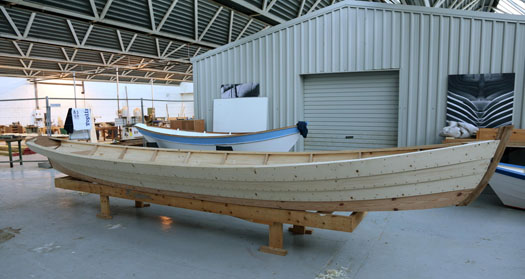
The revival of the traditional Shannon Gandelow is another Ilen Trust project. Photo: Gary MacMahon
Having been in the gondola-building boatyard on one of the Venetian islands (it's a marvellous old workshop, redolent with Stockholm tar and the aromas of fine timber), I have to concede that the Limerick gandelows are only a very distant relation of the classic Venetian originals from which they presumably derived their name. But the international brotherhood of traditional boatbuilding is strong, and the Limerick team will be taking their unusual craft to Venice on 30th April this year for racing displays.

Limerick's Liam O'Donoghue is one of those contemplating the prospect of Shannon gandelows going to Venice to link up with local gondolas. Photo: Gary MacMahon
Meanwhile in Bray so many have been involved with the truly community-wide project to re-create the Droleen class that it might be unfair to single out any one individual, but the popular Barracuda restaurant (it's above the Aquarium on the seafront south of the harbour) has been hugely supportive of a project which has already seen the first boat sailing.
She sets a fascinating rig slightly reminiscent of the setup on the first 1887 double-ended Water Wags. But where the Wags had a standing lug, the Droleens are gunter lug, with the foot of the gaff boom attached to a jaws which slides up and down the mast. Yet that startling spinnaker/jib matches the style of the original Wags, and it anticipates more modern concepts in that, in light airs at any rate, if you keep the spinnaker boom in line with main boom, you can continue to carry the "frontsail" with the wind well forward of the beam.
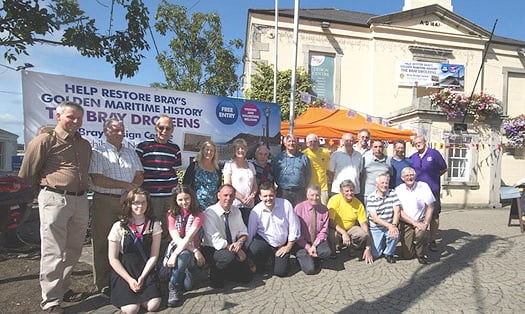
The community group involved with reviving the Droleen class. The first boat will be taking part in Bray's St Patrick's Day Parade.
In the urgency to get the boat sailing before the season had faded away completely, they got a temporary suit of sails stitched up by the fabric shop in Bray's main street, but we're assured that for the season of 2014 they'll have a grown-up suit of sails from noted local sailmaker Harry Sterling. Maybe so, but well done to the fabric shop, their temporary suit looks very well indeed, and the colour is just right to suggest cotton sails of the 1890s.

The new Droleen sailing in Bray Harbour.
The fact that this re-born design has also proven to be an ideal little workboat in on one of the rocky inlets of Connemara is yet another twist in a tale which clearly has legs. And yes, I'm well aware that there are several other wooden boatbuilders in Ireland producing interesting classic and traditional craft each in their own special way. But for now, the Asgard dinghy, the City One performance sailer, the Limerick Gandelow, and the Bray Droleen have given us more than enough to be going along with.
Irish Cruising – Sailing's Magic Elixir for a Long Life
#cruising – Cruising is the hidden side of sailing, yet it's the choice for the majority of those going afloat. Whether it's day cruising, a longer venture in the annual holidays, or the dream cruise of a lifetime across oceans, this is our sport. Unlike racing, which generates its own narrative even if only through the recorded results, much of cruising would slip under the radar completely were it not for cruising awards. W M Nixon considers the latest annual batch from the Irish Cruising Club.
Cruising under sail seems to be the secret of eternal youth. Last night's Annual General Meeting of the Irish Cruising Club in Dun Laoghaire saw a distribution of awards to voyagers from all parts of Ireland who sailed successfully in many areas of the globe in boats mostly of modest size. Yet any outside analyst would soon have made the point that many of the achievers were of mature – sometimes very mature - years, and fulfilling a retirement dream.
But despite any ICC membership gathering these days being a sea of silver heads, age is the last thing they think about. This club of 550 members has become the mixture of an Active Retirement Association – very active indeed, as it happens – and a sort of seagoing extension of the Men's Shed movement.
If you were looking for an illustration of Ireland's changing demographics, and our very rapidly changing attitude as to what constitutes old age, you need look no further than the ICC. Time was when it was thought quite something when one of the club achieved the Golden Jubilee of their membership. But these days, it's no big deal to have been on the strength for fifty years, as the senior member is Joe FitzGerald of Crosshaven, who this year marks 70 years in the club, and he is closely followed by Douglas Mellon who joined in 1947 from Howth - he now lives on the Scottish Riviera in Kircudbright.
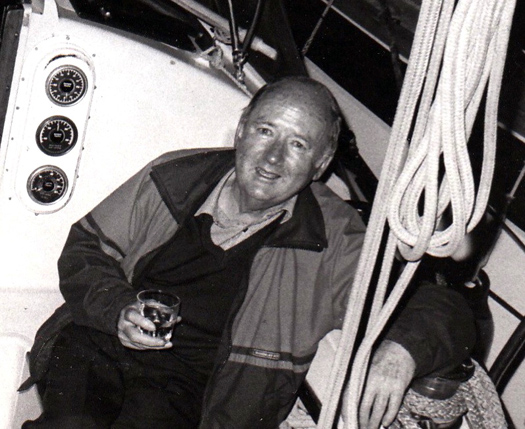
Joe FitzGerald of Cork is the ICC's most senior member, having joined in 1944. He served as Commodore from 1984 to 1987.
All those years ago when they took up their membership, it was thought perfectly normal for young men – married or otherwise - to take off for at least a fortnight's cruising every year, regardless of family demands which these days would be regarded as the prior commitment. In fact, nowadays so much emphasis is placed on family life and families doing just about every last recreational thing together, that younger married sailing people either do extremely short-hop cruising of the type necessitated by catering for the needs of all the members of the family, or else they don't cruise at all in the traditional sense - "Fun For All The Family" effectively rules out proper cruising.
Then too, modern life has so many other distractions - not least of them work demands which involve 24/7 attention - that the old-style easygoing simply-wandering-along holiday cruising is very much a minority activity. This means that at first it seems young people are not taking up traditional cruising at all. But with its deep experience garnered since its foundation in 1929, the Irish Cruising Club has learned to take the long view. It is not unduly concerned by the steadily rising age profile of its membership, and certainly every year there is a significant group of sometimes quite senior yet nevertheless increasingly active cruising enthusiasts joining the club.
They're the embodiment of the slogan that Sailing is a Sport for Life, and it's only politeness which prevents them saying that the subtle pleasures of cruising are wasted on the young. So when you look at the lineup of achievement represented by last night's awards, it's natural to wonder what these people did in earlier life, that they can nowadays afford the time, resources and dedication necessary to complete voyages of this quality.
The adjudication was done by Dave Whitehead of Kinvara on Galway Bay, himself no stranger to the ways of the sea while making long voyages in small craft. He breaks new ground by awarding three trophies at once to Sam Davis of Strangford Lough, whose Cape Horn and Pacific ventures with his Rival 41 Suvretta have been quietly bubbling away in the background of ICC activity for the past three years.
Sam Davis first featured in Afloat magazine in March and April 1981 when we ran his two-part account of his first ocean voyage, an Atlantic circuit from Strangford Lough between 1976 and 1979 with the 34.5ft West Solent Class Suvretta, a former racing boat he'd found in a derelict state and restored to ocean-going condition.

The 34ft West Solent class Suvretta in her offshore racing days in the 1950s when she was based in Belfast Lough. When Sam Davis did the Atlantic Circuit cruise with her in 1976-79, she carried a less loft mainmast, with masthead rig.
But even with Sam's improvements, she was still no more than a slip of a boat, so it says much for his grit and skill that he brought her through the Fastnet storm of 1979 as he sailed the final hundred miles back to Ireland. There was damage aloft, and he'd to get into Dunmore East unaided with jury rigging, but the job was done.
While in the Caribbean, he'd worked in charter yachts between times to make a shilling or two. But after he'd spent time back in Northern Ireland, he went abroad into serious seafaring in offshore service industries, working in places like The Gulf, the North Sea, the Amazon, the Red Sea and Malaysia, becoming a fully accredited Marine Consultant.
Yet if you ask him nowadays what he is and what he was, he'll say he's a farmer and former seaman, as his purchase some years ago of Conly Island in Strangford Lough (you can drive out to it when the tide is down) gives him the little bit of land, and an anchorage too, while "seaman" covers his many experiences in offshore work.
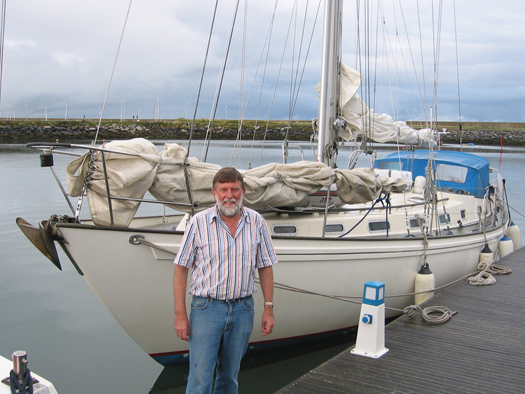
Sam Davis with his newly-acquired Rival 41, re-named Suvretta, in 2009. Photo: W M Nixon

Suvretta in the Beagle Channel in southern Chile. Photo: Sam Davis
Back in 2009 he bought a Rival 41, a hefty and able vessel, a sister-ship of Waxwing in which fellow ICC members Peter and Susan Gray of Dun Laoghaire went round the world 14 years ago. Sam re-named his new boat Suvretta, spent the winter sorting her out, and in 2010 he was gone, sailing south single-handed to eventually round Cape Horn and then spend a long time on the coast of Chile. He was delayed there as a ship broke drift and damaged the boat, but it was well fixed, and he voyaged on into the Pacific to many islands, including Pitcairn and the Tahiti group.
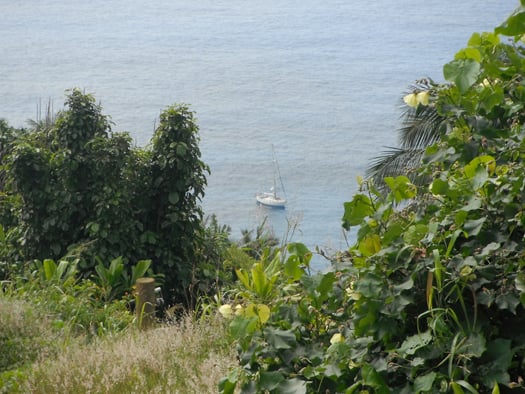
Restless anchorage. Suvretta in Bounty Bay on Pitcairn Island. Photo: Sam Davis
Eventually he fetched up for some time in Tonga, where he became enthused about the 73ft Vakas, the Pacific islanders' contemporary take on the classic Polynesian inter-island vessels (see Sailing on Saturday 11th January 2014). But by November 2012 it was time to head for home, so Suvretta sailed southeast for Cape Horn non-stop, and having rounded it, shaped her course for Port Stanley in the Falklands.
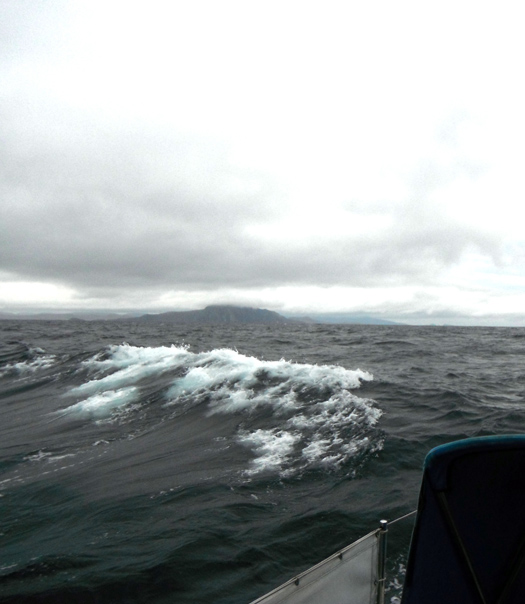
Suvretta rounding Cape Horn for the second time, 21st January 2013. It was only when the Horn was well astern that the weather deteriorated rapidly to make for a challenging approach to Port Stanley. Photo: Sam Davis
However, while rounding the Horn had been simple enough, the passage onwards to Stanley became increasingly fraught, running before rising storm force winds. Conditions were such that it looked for a while as though the lone sailor was going to be swept right past the islands, but he made the cut into shelter to such a nicety that he is awarded the ICC's Rockabill Trophy for Seamanship.
And then when Port Stanley was reached, a very fine passage had been completed from Tonga, so last night for that he was additionally awarded the ICC's Atlantic Trophy for the best voyage with a non-stop leg of more than a thousand miles. And then finally, after they'd spent the mid part of 2013 working their way up the Atlantic with the lone skipper particularly enjoying himself at ports on the Irish coast, Suvretta and Sam returned after three years to Conly Island. And they'd now done more than enough to also be awarded a third trophy - the ICC's premier honour, the Faulkner Cup.

Home again. Sam Davis back in Ireland, August 2013. Photo: W M Nixon
With such a high level of activity by many members, ICC adjudicators always find some final choices to be a very close call, so some years ago the Strangford Cup was inaugurated for the cruise which almost won the Faulkner Cup. This year it has gone to a fine cruise from Portugal to Madeira and through the Azores in detail before returning to Portugal.
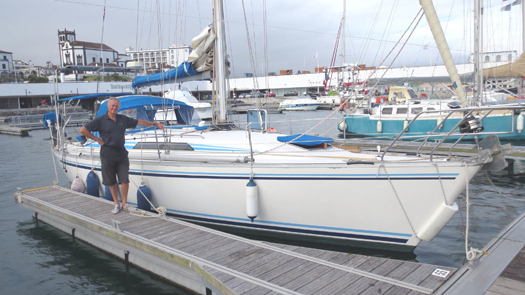
John Duggan with his MG CS40 Hecuba in Horta in the Azores
John Duggan originally hailed from Malahide where he sailed, and he also sailed with the college teams while at Trinity College in Dublin. He cruised and raced offshore mostly in the Irish Sea, but having qualified as an accountant he decided to spread his wings internationally, and he became one of those key people who turn up as partners in one of the big four accountancy firms worldwide.
Eventually his career brought him to the company's offices in Lisbon. Living in Portugal suited him fine, so he put down roots and in time bought himself an interesting cruiser. Hecuba is a 1989 Canadian-built Tony Castro-designed MG CS40, a handsome 12m craft with good performance enhanced by an effective wing keel.
During his final years in the day job he gradually improved the boat with a mind to some proper cruising once he retired at 60, something which he planned with all a high-powered accountant's meticulous attention to detail. He remembers the final day at the office, when a friend on the other side of the world sent him an email: "Even the worst day of your retirement will be better than the best day at work".

Azorean whaleboat with Pico beyond seen during one of Hecuba's cruises from Portugal to the Azores. Photo: John Duggan
Maybe so, yet not everyone makes the changeover smoothly, but in John Duggan's case the challenge of planning and executing remarkably civilised yet challenging cruises has proven to be a complete new job in itself, but much more fun than number crunching. He goes to enormous trouble to make sure that his crews have as enjoyable and varied an experience as possible, yet all the time he is quietly keeping the project moving along while noting details and features of ports visited which might be of interest to fellow skippers, a habit which is the hallmark of the true cruising man.
When you live in Cascais with your boat based in the marina nearby, the Azores are the western isles which call you each summer. But unlike Scotland's Western Isles which are just a day's sail away across the Sea of the Hebrides, the Azores involve an immediate ocean voyage from Portugal of at least 500 miles. However, for 2013's cruise west, Hecuba made it a triangle, going first to Madeira before going on nor'west to the Azores which were cruised in detail before returning to Cascais after six weeks away, having logged 2390 miles, with the final tabulation being:
Hours spent close hauled: Zero.
Cross words exchanged: Zero.
Inevitably the two big awards dominate the scoresheet, but the ICC also has a host of trophies which reflect every level of club sailing activity. The Round Ireland Cup, for instance, is for the circuit which produces most information for the club's sailing directions, and in a year in which a goodly number went round, it was Donal Walsh of Dungarvan with his Moody 31 Lady Kate who best filled the bill.

Donal Walsh's Lady Kate anchored at Inishmurray off the Sligo coast during his detailed round Ireland cruise. Photo: Donal Walsh
As the Faulkner Cup was first won in 1931 by the 28ft cutter Marie, the Marie Trophy is for the best cruise by a boat under 30ft, and Mick Delap from Valentia Island with his Tamarisk 24 gaff cutter North Star fits into the size requirement with six feet to spare. He made a fine job of completing a two-summer circuit of Ireland by returning from western Scotland via the Irish Sea and Ireland's south and southwest coasts.

Mick Delap's Tamarisk 24 North Star from Valentia in Lowlandman's Bay in Jura in the Hebrides. Photo: Mick Delap
In all, the ICC has a dozen cruising trophies. But even so not everyone gets one in a typically busy year, so to encourage the newcomers they've the Perry Greer Trophy for first time log-writers, and it goes to Peter Mullan from the Quoile in Strangford Lough for his insightful account of a round Ireland cruise with the Jeanneau Sun Odyssey Sancerre.
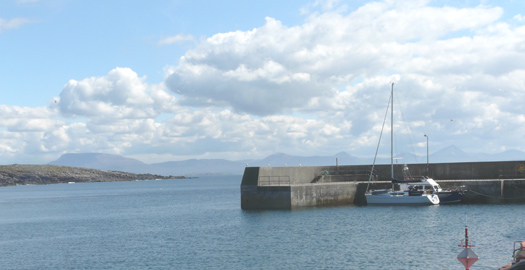
Peter Mullan's Sun Odyssey Sancerre in the little harbour at Tory Island with the Donegal highlands beyond. Photo: Peter Mullan
All the logs, including the winning ones, were featured in the ICC's 180-page Annual 2013, which Honorary Editor Ed Wheeler managed to get to the members in time for Christmas. All this is done by voluntary effort, yet the Annual would stand up to professional comparisons, as it includes informative accounts of cruises in just about every part of the world, plus a report on the ICC Cruise-in-Company to the Isles of Scilly which was an outstanding success despite coinciding with some uneven weather in June.
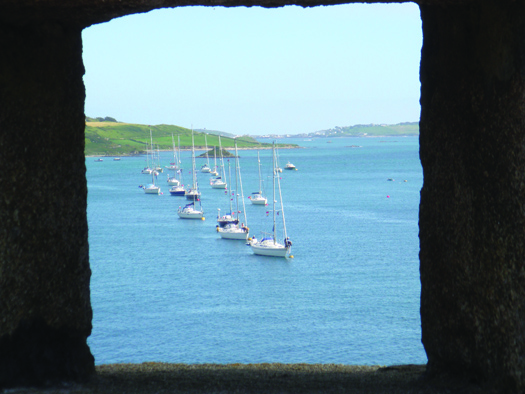
The Irish Cruising Club flotilla in the Isles of Scilly during their successful Cruise-in-Company in June 2013.

Everyone to his taste. ICC member Brian Black went to Greenland for the sixth time, crewing on Aurora. This is Kangertitiatsivaq Fjord in high summer. Photo: Brian Black
There's more to the Club than the Annual, as the ICC's programme of producing constantly up-dated Sailing Directions for the entire Irish coast in two volumes is a continuous progression, with the latest 12th Edition of the North & East Coast Book due next month from Honorary Editor Norman Kean, whose home port is Courtmacsherry.
Thus it's clear that Ireland's cruising club is a truly all-Ireland organisation, and this year it will be celebrating its 85th birthday with a Cruise-in-Company to Glengarriff where it was founded on July 13th 1929. Yet despite its obvious significance, this is a club without premises. In the final analysis, it's a club of the mind, made up of kindred spirits. Heading such a body is a mighty challenge, and the changing of the watch is always a charged moment.
Last night David Tucker of Kinsale stood down after serving his three years as Commodore, and he was succeeded by Peter Killen of Malahide. His experience in club administration is long-lived – he was Commodore of Malahide YC when it became "Club of the Year" in 1980. But it was his cruising CV which next went into overdrive, as in 1993 he voyaged north to Iceland, circled it, and then sailed back in near-record time in an S&S 30. He then moved up to a Sigma 36 which he cruised to Greenland among other places, following which he cruised even further with a Sweden 38, and then in 2004 he took on his dreamship, the Amel Maramu 54 Pure Magic.
Peter Killen seems to have cruised this very special boat just about everywhere. Not least was deep into Antarctica, where he made a memorable arrival in zero visibility with icy conditions into the natural harbour in the extinct volcanic crater on Deception Island. It was all a long way in time and distance from five boats gathered in Glengarrif in the hope of forming a little cruising organisation back in 1929. But that's the way it is with the Irish Cruising Club.





























